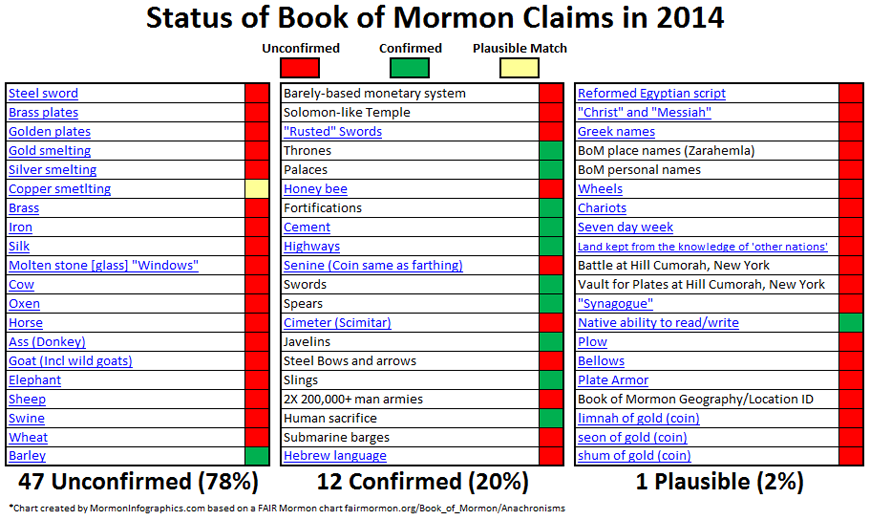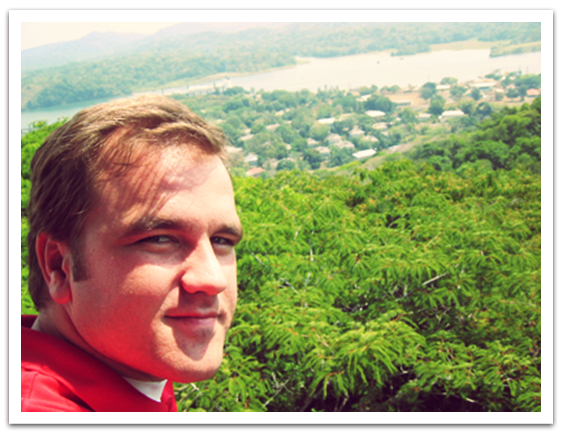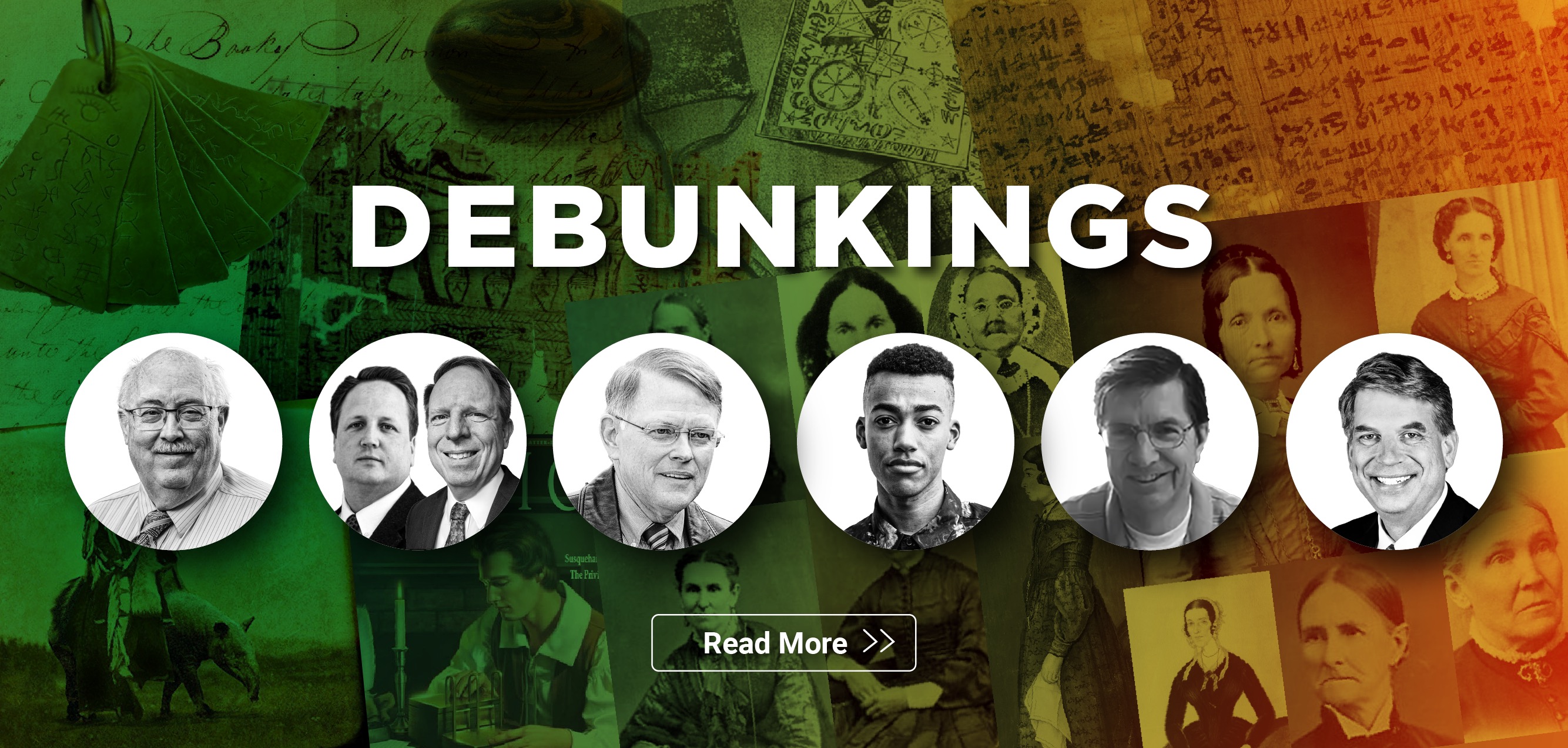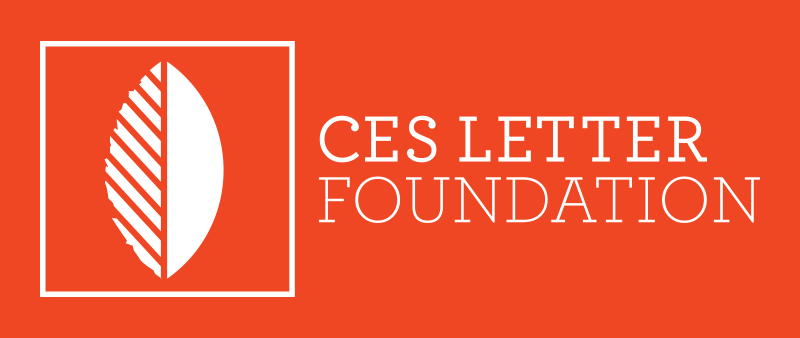Detailed Response
Book of Mormon
The absence of evidence is not proof. Here’s one small example:
Matthew Roper in a FairMormon Blog on June 17, 2013, writes about a criticism repeated many times over the years about the mention of steel in the Book of Mormon. In 1884, one critic wrote, “Laban’s sword was steel, when it is a notorious fact that the Israelites knew nothing of steel for hundreds of years afterwards. Who but as ignorant a person as Rigdon would have perpetuated all these blunders.” More recently, Thomas O’Dea in 1957 stated, “Every commentator on the Book of Mormon has pointed out the many cultural and historical anachronisms, such as the steel sword of Laban in 600 B.C.”
We had no answer to these critics at the time, but as often happens in these matters, new discoveries in later years shed new light. Roper reports, “It is increasingly apparent that the practice of hardening iron through deliberate carburization, quenching and tempering was well known to the ancient world from which Nephi came. ‘It seems evident,’ notes one recent authority, ‘that by the beginning of the tenth century B.C. blacksmiths were intentionally steeling iron.’” In 1987, the Ensign reported that archeologists had unearthed a long steel sword near Jericho dating back to the late seventh century B.C., probably to the reign of King Josiah who died shortly before Lehi began to prophesy. This sword is now on display at Jerusalem’s Israel Museum. The museum’s explanatory sign reads in part, “The sword is made of iron hardened into steel, attesting to substantial metallurgical know-how.”
—Elder D. Todd Christofferson, "The Prophet Joseph Smith",
Brigham Young University-Idaho Devotional, September 24, 2013.
Jeremy's Response
Elder Christofferson creates the following strawman: "There was steel in the Middle East around the time of Lehi, so maybe there was steel in America at the same time."
The problem, however, doesn’t lie with the ability or knowledge to produce steel at the time Lehi lived. The problem lies in the fact that no ancient American steel tools or weapons (or traces or evidence of them or their manufacture) have ever been found. Elder Christofferson is using a strawman by sidestepping the actual argument (that no steel has ever been found in ancient America) and refuting a weaker argument (that steel was not capable of being manufactured at the time of Lehi).
The Book of Mormon describes vast battles, with military forces dwarfing those of the Roman Empire (the Roman military maxed out around 350,000 soldiers) involving the heavy use of metallurgy. Contrary to the accounts in the Book of Mormon, not a single steel sword, helmet, armor, chariot, spear, etc. has been found.
There is zero evidence for the argument Elder Christofferson failed to address. No steel has ever been found in ancient America. That steel was manufactured in the seventh century BC in the Middle East has no bearing on whether steel was manufactured or used on a massive scale in ancient America, as depicted in the Book of Mormon. Christofferson's argument is like saying, “The Chinese could make fireworks a long time ago, so maybe the Europeans could likewise make fireworks at the same time.” Sure, they maybe could have, but there is no evidence that they did.
While it is true that the absense of evidence does not necessarily prove (with 100% certainty) that something never existed, the absence of evidence does decrease the likelihood that something existed. The notion that the absence of evidence is evidence of absence is not just a rule of thumb – it is a law of Probability Theory. If there is some hypothesis H and some event E such that P(E|H) > P(E), we know that P(H|E) > P(H), or “E is evidence in favor of H.” If this is the case, it is also true that P(~E|H) <P(~E), so we can conclude that P(H|~E) <P(H), or “not observing E lowers the probability of H.” This video demonstrates mathematical proof that absence of evidence is evidence of absence.
Mormon apologists and now the Church (since one of its apostles just used it) often commit the fallacy of equivocation with the “absence of evidence” phrase, which can have multiple implied definitions:
The most useful definition of “absence of evidence” is “lack of data.”
There is another definition: “Lack of presence.”
These are not the same things. If you check some area for steel artifacts and do not find any, you don’t have “lack of data.” You have data. You know that there are no steel artifacts in that area. You get a ‘0’ instead of a ‘1’ in your grid for that ground. In the case of steel in North America, we can have checked a sufficient % of the ground for evidence of steel, find nothing, and actually have lots of data, not just an ‘absence of evidence’ (lack of presence).
Here is an analogy to further illustrate this point:
Banana-ist: There’s a banana FairMormony that leaves everyone in the world bananas on their pillow in the morning.
A-Banana-ist: I’ve never had a banana on my pillow in the morning so therefore the thing you describe doesn’t exist.
Banana-ist: AHA! But absence of evidence isn’t evidence of absence!
A-banana-ist: I’m not talking about ‘absence of evidence,’ the ‘lack of bananas’ in this case is actually evidence that disproves your assertion, because your Banana FairMormony has the testable property of “leaving bananas on everyone’s pillow in the morning.” There may be other FairMormonies with other properties, but I have evidence of a lack of bananas, and that is evidence of the absence of a Banana FairMormony.
And here's an even more obvious analogy:
Someone claims that they keep an elephant in their garage. A perfectly normal and visible large gray elephant. You go to look and you cannot see any elephant. You enter the garage, which is quite small, and look around. There is no elephant smell or any elephant droppings. In fact, there is a total lack of evidence of any sort which would indicate or suggest there is an elephant in the garage. You would quite reasonably assume that the absence of elephantine evidence indicated the absence of the elephant.
The Book of Mormon is an elephant in a garage. Like the elephant, it makes enough claims that it’s virtually certain we’d find evidence after almost 200 years of searching. So, not finding any evidence is evidence against the book and its claims.
FairMormon should know better than to make a claim without evidence only to turn around and ask for it in return from the critics.
“What can be asserted without evidence can be dismissed without evidence.”
– Christopher Hitchens –
What are 1769 King James Version edition errors
doing in the Book of Mormon?
"What are 1769 King James Version edition errors doing in the Book of Mormon? An ancient text? Errors which are unique to the 1769 edition that Joseph Smith owned?"
- FairMormon agrees that there are 1769 King James Version errors present in the Book of Mormon.
- It is known that Oliver Cowdery purchased a Bible from E.B. Grandin on 8 October 1829. The Book of Mormon copyright was registered on 11 June 1829, and the translation was completed in late June. Prior to that time, the only Bible Joseph is known to have had access to was the Smith family Bible, which was not in his possession after he married and moved out of the Smith home.
FairMormon deleted their above response. See screenshot.
Jeremy's Response to FairMormon
This is just misdirection. Here are the facts:
- There are 17th century KJV additions (denoted by italics in the KJV) in the Book of Mormon.
- There are 1769 KJV Bible edition errors unique to only that edition present in the Book of Mormon.
- FairMormon concedes below that while there are no reports from witnesses that Joseph used an open Bible, “it is entirely possible that Joseph had access to a Bible during the period of translation.”
- FairMormon awkwardly points to the Mormon god Himself as a possible source for putting unique 1769 KJV edition errors and 17th century italics in the “most correct book on earth” Book of Mormon: “...we do not claim to know why the Lord chose to reveal the Biblical passages in that manner.”
The presence of 17th century KJV italics and 1769 KJV errors – word for word – in the Book of Mormon is its own damning evidence. These errors totally undermine the claim that Joseph “translated” the Book of Mormon and the claim that the Book of Mormon is the most correct book on earth.
Like a crime scene, we do not need a video recording or an affidavit from the suspect or a witness to show whether or not the suspect murdered with a gun. The body riddled with 9mm bullets and the presence of 9mm shell casings on the floor is sufficient evidence to establish the fact that the suspect used a 9mm pistol in the murder.
In the case of 17th century KJV italics and 1769 KJV edition errors in an ancient text such as the Book of Mormon? Whether or not we have direct evidence that Joseph Smith had a 1769 KJV edition Bible or access to it during translation is irrelevant and diversionary to the real question asked in a different way: Why are there “9mm bullets” in a body that existed only between 2200 BC – 421 AD? Thousands of years before “9mm bullets” even existed?
- Joseph dictated the text of most of the Book of Mormon in the open in front of witnesses using the stone and the hat, a point clearly acknowledged by critics of the Church. These witnesses never reported that a Bible or any other book was present during the translation.
FairMormon deleted their above response. See screenshot.
Jeremy's Response to FairMormon
FairMormon acknowledges the evidence of 1769 KJV errors and 17th century KJV italics in the Book of Mormon and the weakness of relying on the argument that the “witnesses never reported that a Bible or any other book was present during the translation,” by conceding below that “it is entirely possible that Joseph had access to a Bible during the period of translation.”
That the witnesses never reported Joseph looking at a 1769 KJV Bible during the translation process actually enhances the likelihood that the Book of Mormon is a fraud. Ignoring the possibility that God himself revealed the errors, at best Joseph was reciting from memory passages from the 1769 KJV Bible, rather than “dictating,” as FairMormon phrases it. At worst, Joseph waited until the witnesses weren’t around to consult and copy from the 1769 KJV Bible.
In any event, the inclusion of errors unique to the 1769 KJV Bible edition and 17th century KJV translator’s italics in the Book of Mormon – word for word – is its own utterly damning evidence.
- Church answer:
The September 1977 Ensign suggests that Joseph may have adopted the Isaiah passage wording from the King James Bible:
In fact, the language in the sections of the Book of Mormon that correspond to parts of the Bible is quite regularly selected by Joseph Smith, rather than obtained through independent translation. For instance, there are over 400 verses in which the Nephite prophets quote from Isaiah, and half of these appear precisely as the King James version renders them. Summarizing the view taken by Latter-day Saint scholars on this point, Daniel H. Ludlow emphasizes the inherent variety of independent translation and concludes: “There appears to be only one answer to explain the word-for-word similarities between the verses of Isaiah in the Bible and the same verses in the Book of Mormon.” That is simply that Joseph Smith must have opened Isaiah and tested each mentioned verse by the Spirit: “If his translation was essentially the same as that of the King James version, he apparently quoted the verse from the Bible.” Thus the Old Testament passages from Isaiah display a particular choice of phraseology that suggests Joseph Smith’s general freedom throughout the Book of Mormon for optional wording.
—Richard Lloyd Anderson, "By the Gift and Power of God," Ensign (September 1977) (emphasis added)
FairMormon deleted their above response. See screenshot.
Jeremy's Response to FairMormon
This claim contradicts many accounts of how the translation actually happened. As Book of Mormon witness David Whitmer described the rock-in-the-hat translation method:
“Joseph Smith would put the seer stone into a hat, and put his face in the hat, drawing it closely around his face to exclude the light; and in the darkness the spiritual light would shine. A piece of something resembling parchment would appear, and on that appeared the writing. One character at a time would appear, and under it was the interpretation in English. Brother Joseph would read off the English to Oliver Cowdery, who was his principal scribe, and when it was written down and repeated to Brother Joseph to see if it was correct, then it would disappear, and another character with the interpretation would appear.”
– Quoted in Elder Russell M. Nelson’s “A Treasured Testament”
FairMormon’s claim likewise contradicts several other witness accounts, including those of Martin Harris, and the Church’s recent Gospel Topics article on the translation process, which states that “Joseph placed either the interpreters or the seer stone in a hat, pressed his face into the hat to block out extraneous light, and read aloud the English words that appeared on the instrument.”
Joseph did not have, according to these accounts, "general freedom" for “optional wording” in the Book of Mormon. The exact words came off the stone in the hat.
- Therefore, given that historical sources (and the critics) confirm that Joseph dictated in the open in front of witnesses without consulting a Bible, one possible conclusion that a believing member can reach to explain the presence of Bible passages which match the King James Version is that the Lord revealed them to Joseph in that manner. Another possible conclusion is that when Joseph encountered Biblical passages, that he consulted a Bible and simply used the text, although this does not explain how he managed to dictate it from memory. In either case, we do not claim to know why the Lord chose to reveal the Biblical passages in that manner.
FairMormon deleted their above response. See screenshot.
Jeremy's Response to FairMormon
Note: FairMormon deleted the following FairMormon response on 10.6.13:
“The only description of the translation process that Joseph Smith ever gave was that it was performed by the ‘gift and power of God,’ and that the translation was performed using the ‘Urim and Thummim.’ Since Joseph translated in the open using the stone and the hat, and witnesses never reported that a Bible or any other book was present during the translation, the only conclusion that we can reach to explain the presence of Bible passages which match the King James Version is that the Lord revealed them to Joseph in that manner. We do not know the reason for this.”
We don’t know why but we know that God gave Joseph Smith 1769 King James edition errors – unique to only the 1769 edition – to put into the Book of Mormon? This is the best FairMormon can do?
Again, there is no legitimate reason for God to have revealed errors to Joseph. The errors undermine the claims that the Book of Mormon is a translation and that it is the most correct book.
Perhaps the reason why FairMormon can only come to the conclusion that God gave Joseph Smith 1769 KJV edition errors to put into the Book of Mormon is because FairMormon refuses to acknowledge the possibility that God wasn’t involved with the creation of the Book of Mormon at all.
- Quotes to consider
Joseph Smith stated the following in July 1838:
Question 4th. How, and where did you obtain the book of Mormon? Answer. Moroni, the person who deposited the plates, from whence the book of Mormon was translated, in a hill in Manchester, Ontario County, New York, being dead, and raised again therefrom, appeared unto me, and told me where they were; and gave me directions how to obtain them. I obtained them and the Urim and Thummim with them; by the means of which I translated the plates and thus came the book of Mormon. (Joseph Smith, (July 1838) Elders Journal 1:42-43.)
FairMormon deleted their above response. See screenshot.
Jeremy's Response to FairMormon
The problem with Joseph’s 1838 claim is that it’s untrue. Joseph did not translate the Book of Mormon we have today with the Urim and Thummim or the physical plates. He used a rock in a hat. A rock he found on his neighbor’s property in 1822. This is the exact same method that Joseph used to con people out of their money in his family’s treasure hunting business. FairMormon concedes that Joseph used a rock in a hat for translating the Book of Mormon here.
- The author copied his information from the anti-Mormon site “Mormon Handbook”
FairMormon deleted their above response. See screenshot.
Jeremy's Response to FairMormon
I am glad that FairMormon brings this up as this is an excellent Case Study of how the Church and Mormon apologists use the Orwellian “anti-Mormon” card as a scary boogeyman in intimidating and discouraging Latter-day Saints from actually engaging in balanced research about the Church and its history.
The following graphics and information are what I borrowed from the so-called “anti-Mormon” Mormon Handbook website:
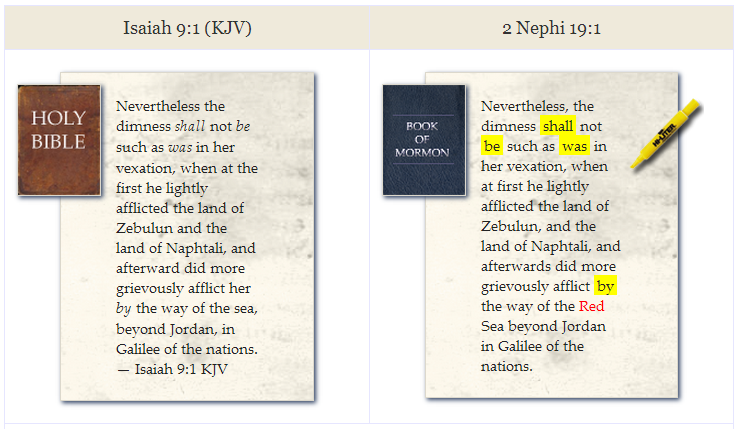
The above example, 2 Nephi 19:1, dated in the Book of Mormon to be around 550 BC, quotes nearly verbatim from the 1611 AD translation of Isaiah 9:1 KJV – including the translators’ italicized words. Additionally, Joseph qualified the sea as the Red Sea. The problem with this is that (a) Christ quoted Isaiah in Matt. 4:14-15 and did not mention the Red Sea, (b) “Red” sea is not found in any source manuscripts, and (c) the Red Sea is 250 miles away.
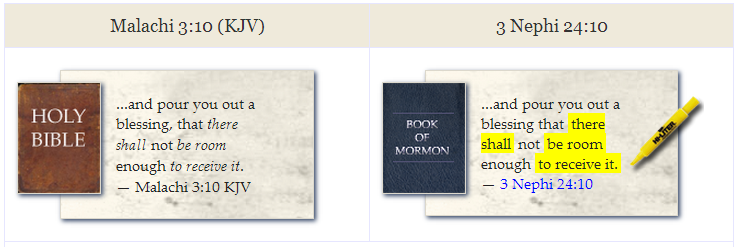
In the above example, the KJV translators added 7 italicized words not found in the source Hebrew manuscripts to its English translation. Why does the Book of Mormon, completed 1,200 years prior, contain the exact identical seven italicized words of 17th century translators?
Notice that FairMormon does not say that this is false, that it’s a lie, or that it’s incorrect.
The following hypothetical conversation between FairMormon and an informed Latter-day Saint illustrates the weakness in FairMormon’s criticism:
FairMormon: “This information is copied from an ‘anti-Mormon’ website!”
Informed Latter-day Saint: “So? Is it true or is it false that the Book of Mormon contains 1769 KJV errors and 17th century translator’s italics?”
FairMormon: “Well, yes, there are 1769 KJV errors and 17th century translator’s italics present in the Book of Mormon…but God may have given them to Joseph to put in there!”
Informed Latter-day Saint: “…so…the critic’s claim that 1769 KJV errors and 17th century italics in the Book of Mormon is indeed valid and true? Why did you pull out the ‘anti-Mormon’ card then? What purpose did you hope to accomplish by bringing up the loaded ‘anti-Mormon’ label to begin with? To scare and intimidate me from looking further into the evidence? To make me dismiss the entire claim altogether as soon as I heard the trigger words? To keep me from seeing that the critics – at least in this case – are correct?”
The above graphics from this so-called “anti-Mormon” website simply list scriptures that every Latter-day Saint has access to. All you have to do is pull out the scriptures and compare the Book of Mormon verses to the KJV Bible verses to see that the 17th century italics are indeed present in the supposed ancient Book of Mormon text.
FairMormon is just attempting to intimidate their Latter-day Saint readers from looking at the evidence by labeling it “anti-Mormon,” while ironically conceding that the evidence is true and factual.
Matt shares the problems and absurdities of the Church’s and Mormon apologetic use of the "anti-Mormon" card and how it does not serve Latter-day Saints in their quest for truth:
What are these 17th century italicized words doing in the Book of Mormon?
The document asks why italicized words from the King James Bible are present in the Book of Mormon?
- FairMormon agrees that there are 17th century King James Version translator’s italicized words present in the Book of Mormon.
- There was no Bible in evidence during the dictation, which was performed in the open in from of witnesses, as Joseph looked into the stone in the hat.
- It is entirely possible that Joseph had access to a Bible during the period of translation, despite the fact that no witnesses ever reported this. In this case, Joseph may have simply selected the wording of these passages to represent what was revealed to him.
FairMormon deleted their above response. See screenshot.
Jeremy's Response to FairMormon
“In this case, Joseph may have simply selected the wording of these passages to represent what was revealed to him.”
There are major problems with this assertion. First, no witness account of the translation process confirms that Joseph consulted the Bible during the process. Second, the official 2013 Church article on the translation process, as well as contemporary eyewitness accounts, contradict this assertion. As stated above, the Church’s recent Gospel Topics article states that “Joseph placed either the interpreters or the seer stone in a hat, pressed his face into the hat to block out extraneous light, and read aloud the English words that appeared on the instrument.”
Next, Book of Mormon witness David Whitmer (as well as other witnesses) debunks FairMormon’s “loose translation” theory:
“Joseph Smith would put the seer stone into a hat, and put his face in the hat, drawing it closely around his face to exclude the light; and in the darkness the spiritual light would shine. A piece of something resembling parchment would appear, and on that appeared the writing. One character at a time would appear, and under it was the interpretation in English. Brother Joseph would read off the English to Oliver Cowdery, who was his principal scribe, and when it was written down and repeated to Brother Joseph to see if it was correct, then it would disappear, and another character with the interpretation would appear.”
– Quoted in Elder Russell M. Nelson’s “A Treasured Testament”
The key concession made by FairMormon here is their acknowledgment that it is indeed possible that Joseph consulted the KJV Bible for writing the Book of Mormon. This is supported by the damning evidence of 1769 KJV errors and 17th century italics – word for word – in the Book of Mormon.
The Book of Mormon includes mistranslated biblical passages
that were later changed in Joseph Smith’s translation of the bible.
The Book of Mormon includes mistranslated biblical passages
that were later changed in Joseph Smith’s translation of the bible.
- FairMormon agrees that the Book of Mormon contains passages that were later changed in Joseph’s translation of the Bible.
- If Joseph copied Biblical passages during the Book of Mormon translation to represent ideas expresses by Isaiah (as suggested in the September 1977 Ensign), then it is understandable that he changed or corrected some of these instances during his work on the “Joseph Smith Translation” of the Bible. Joseph did not claim to be mechanically preserving some hypothetically ‘perfect’ Biblical text. Rather, Joseph used the extant King James text as a basis for commentary, expansion, and clarification based upon revelation, with particular attention to issues of doctrinal importance for the modern reader. Modern readers are accustomed to thinking of a ‘translation’ as only the conversion of text in one language to another. But, Joseph used the term in a broader and more inclusive sense, which included explanation, commentary, and harmonization. The JST is probably best understood in this light.
FairMormon deleted their above response. See screenshot.
Jeremy's Response to FairMormon
Contrary to FairMormon’s assertion above that God himself revealed the 1769 KJV errors to Joseph, FairMormon is conceding here that Joseph copied KJV text over to the Book of Mormon.
According to the above-referenced September 1977 Ensign, Joseph Smith was sitting there translating the Book of Nephi when he recognized the text as Isaiah, stopped the translation, put down his hat and magical rock, picked up his 1769 KJV Bible, and copied over the Isaiah verses including its unique 1769 KJV errors and italics into the “most correct book” Book of Mormon.
Am I really supposed to take this seriously?
Why would Joseph need to do this? How does it make any sense that Joseph stops translation coming direct from God to grab errors and italics from a book that has been corrupted over the centuries through numerous translations? A Bible that Joseph later pointed to as needing correction and which he “corrected” in his “inspired” translation of the Bible?
In any event, this scenario is contradicted by eyewitness accounts of the translation process, as well as the process described by the Church’s December 2013 Gospel Topics article.
“Modern readers are accustomed to thinking of a 'translation' as only the conversion of text in one language to another.”
This make sense, given the multitude of sources (including the Church-sanctioned Gospel Topics article) supporting a “tight” translation method, including the following account from David Whitmer:
“Joseph Smith would put the seer stone into a hat, and put his face in the hat, drawing it closely around his face to exclude the light; and in the darkness the spiritual light would shine. A piece of something resembling parchment would appear, and on that appeared the writing. One character at a time would appear, and under it was the interpretation in English. Brother Joseph would read off the English to Oliver Cowdery, who was his principal scribe, and when it was written down and repeated to Brother Joseph to see if it was correct, then it would disappear, and another character with the interpretation would appear.”
– Quoted in Elder Russell M. Nelson’s “A Treasured Testament”
If the Bible verses were good enough for the "most correct book," there is no reason to change them in the JST of the Bible (other than to obfuscate the plagiarism). If Joseph was trying to make the Bible more correct, he would not change something that was correct according to Isaiah.
As I have stated in the CES Letter:
Joseph Smith corrected the Bible. In doing so, he also corrected the same identical passage in the Book of Mormon. The Book of Mormon is “the most correct book” and was translated a mere decade before the JST. The Book of Mormon was not corrupted over time and did not need correcting. How is it that the Book of Mormon still has the incorrect passage and does not match the JST in the first place?
DNA analysis has concluded that Native American
Indians do not originate from the Middle East
“DNA analysis has concluded that Native American Indians do not originate from the Middle East or from Israelites but rather from Asia.” The author then asks why the Church changed the introduction to the Book of Mormon from “…the Lamanites, and they are the principal ancestors of the American Indians” to “…the Lamanites, and they are among the ancestors of the American Indians”.
- FairMormon agrees that DNA evidence do not show Middle Eastern or Israelite DNA in Native American Indians but attempt to diminish this with their unsupported integration theory.
- FairMormon agrees that Church changed Book of Mormon introduction in 2006.
- The Church made the change to remove the assumption, inserted into the Book of Mormon introduction in the 1920's, that all of the inhabitants of the Americas were descendants of Lehi. This had been the generally held belief from the time that the Church was restored.
FairMormon deleted their above response. See screenshot.
Jeremy's Response to FairMormon
Important Note: The LDS Church made FairMormon's opinions and theories obsolete by releasing its official essay on the Book of Mormon and DNA Studies.
The Church's official January 2014 essay can be read here.
A critic's response to the Church's official Book of Mormon and DNA Studies essay can be read here.
I like how FairMormon calls a 170+ year Mormon teaching believed and taught by “prophets, seers, and revelators” an “assumption.” It was not an “assumption.” It was a teaching accepted and taught by these “prophets, seers, and revelators,” including Joseph Smith himself, for most of the Church’s entire existence until the Church quietly and unofficially made the change in the Book of Mormon in 2006, after the DNA evidence started pouring in.
The Prophet Joseph Smith disagrees with FairMormon’s “integration” and “Limited Geography” theories. This is what Joseph stated in the March 1, 1842 Wentworth Letter:
“In this important and interesting book the history of ancient America is unfolded, from its first settlement by a colony that came from the Tower of Babel at the confusion of languages to the beginning of the fifth century of the Christian era. We are informed by these records that America in ancient times has been inhabited by two distinct races of people. The first were called Jaredites and came directly from the Tower of Babel. The second race came directly from the city of Jerusalem about six hundred years before Christ. They were principally Israelites of the descendants of Joseph. The Jaredites were destroyed about the time that the Israelites came from Jerusalem, who succeeded them in the inheritance of the country. The principal nation of the second race fell in battle towards the close of the fourth century.” (Emphasis added).
Thus, the Prophet Joseph Smith claimed that America was uninhabited prior to the arrival of the Jaredites around 2,200 BC, which we now know is incorrect. Joseph also claims that Jaredites came from the Tower of Babel, an event that respectable biblical scholars, linguistics, and scientists all concur as not being a literal event.
Perhaps it’s for this very reason that the Church omitted this very paragraph from its Teachings of Presidents of the Church: Joseph Smith on LDS.org. Notice that the entire Wentworth Letter is there word for word except for the above paragraph.
What’s hilarious about this is that Joseph Smith gave explicit instructions that “all that I shall ask at his hands is that he publish the account entire, ungarnished, and without misrepresentation” in the header of the letter and here his own Church in the 21st century is not following the Prophet’s own instructions by editing the letter and omitting and hiding the above paragraph of the letter from members of the Church in its Joseph Smith manual.
Perhaps even more important than what Joseph himself believed is how Joseph claimed to have received this knowledge regarding the ancient American inhabitants. Specifically, Joseph claimed to have received this knowledge from Moroni and other angels. Joseph described the teachings he received from Moroni in the Wentworth letter:
"I was also informed concerning the aboriginal inhabitants of this country [America] and shown who they were, and from whence they came; a brief sketch of their origin, progress, civilization, laws, governments, of their righteousness and iniquity, and the blessings of God being finally withdrawn from them as a people, was [also] made known unto me; I was also told where were deposited some plates on which were engraven an abridgment of the records of the ancient prophets that had existed on this continent. The angel appeared to me three times the same night and unfolded the same things. After having received many visits from the angels of God, unfolding the majesty and glory of the events that should transpire in the last days, on the morning of the 22nd of September, A.D. 1827, the angel of the Lord delivered the records into my hands." (Emphasis added).
Indeed, Moroni visited Joseph at least 22 times over the course of Joseph’s life. In addition, Elder John Taylor taught that Joseph Smith was visited by Nephi, who would have had first-hand knowledge of the accuracy of the “integration” theory.
Joseph’s mother, Lucy Mack Smith, described Joseph’s knowledge of the ancient Americans, which Joseph relayed after Moroni’s initial visit:
"During our evening conversations, Joseph would occasionally give us some of the most amusing recitals [reports] that could be imagined. He would describe the ancient inhabitants of this continent, their dress, mode of traveling, and the animals upon which they rode; their cities, their buildings, with every particular; their mode of warfare; and also their religious worship. This he would do with as much ease, seemingly, as if he had spent his whole life with them."
In short, Joseph did not merely believe that the people described in the Book of Mormon were the original inhabitants, he claimed to have been informed as much by angelic visitors. Thus, in order to believe in an “integration” or “limited geography” theory, one must believe not only that Joseph was mistaken in his beliefs, but also that angelic ministers (some of whom were ancient inhabitants themselves) deliberately misled Joseph when teaching him about the origins of America’s ancient inhabitants. I seriously doubt that Chapel Mormons are prepared to believe in lying angels.
Another example of this teaching being accepted and taught by a latter-day prophet was Spencer W. Kimball’s “Of Royal Blood” talk in the July 1971 Ensign, which is quoted below.
- This change makes the Book of Mormon introduction compatible with current DNA evidence and acknowledges the fact that Lehi's group likely intermingled with the native inhabitants of the American continents based upon current knowledge of the DNA composition of the inhabitants of the New World. There is substantial scientific evidence of habitation in the Americas for thousands of years prior to Lehi's arrival.”
FairMormon deleted their above response. See screenshot.
Jeremy's Response to FairMormon
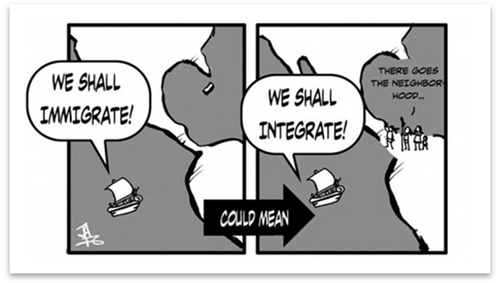
The notion that Lehi & Co. “likely intermingled with existing natives” only ever came after DNA sequencing in the 1990s and 2000s proved that Lehi and his offspring were not the only inhabitants of the Americas after all. There is a reason why the belief that the inhabitants of the Americas were descendants of Lehi “had been the generally held belief from the time that the Church was restored.” Joseph Smith believed in a hemispheric model, and he claimed to have been taught as much by angelic beings, at least one of which lived among the ancient civilizations himself. He believed that all of the Native American Indians were direct descendants of Lehi. He sent missionaries to the “Lamanites” to preach this teaching. So did the “prophets, seers, and revelators” after him. President Spencer W. Kimball was a major believer and proponent of the Church teaching that the Indians are the principal descendants or ancestors of Lehi. This is what Kimball said regarding the Indians:
“With pride I tell those who come to my office that a Lamanite is a descendant of one Lehi who left Jerusalem six hundred years before Christ and with his family crossed the mighty deep and landed in America. And Lehi and his family became the ancestors of all of the Indian and Mestizo tribes in North and South and Central America and in the islands of the sea, for in the middle of their history there were those who left America in ships of their making and went to the islands of the sea. Not until the revelations of Joseph Smith, bringing forth the Book of Mormon, did anyone know of these migrants. It was not known before, but now the question is fully answered. Now the Lamanites number about sixty million; they are in all of the states of America from Tierra del Fuego all the way up to Point Barrows, and they are in nearly all the islands of the sea from Hawaii South to New Zealand … The descendants of this mighty people were called Indians by Columbus in 1492 when he found them here. The term Lamanite includes all Indians and Indian mixtures, such as Polynesians, the Guatemalans, the Peruvians, as well as the Sioux, the Apache, the Mohawk, the Navajo, and others. It is a large group of great people.” – Spencer W. Kimball, “Of Royal Blood,” Ensign July 1971. (Emphasis added)
The Church does not officially acknowledge that “Lehi’s group likely intermingled with the native inhabitants.” The Church just quietly replaced “principal” to “among the” in the Book of Mormon title page in 2006 after the DNA verdicts came in. The Church has been especially silent on the issue since the DNA evidence surfaced. FairMormon is attempting to put words into the Church’s mouth.
There is substantial scientific evidence of habitation in the Americas for thousands of years prior to the claimed Lehi and yes, Jaradite arrivals. There is no evidence, on the other hand, that Lehi and his family “intermingled with the native inhabitants of the American continents.”
There is no DNA evidence of any Hebrew or Middle Eastern markers in the DNA composition of the natives of the Americas.
It is a scientific fact that even if Lehi’s group had integrated, instead of being the sole occupants of the Americas, as everyone in the Church – including its prophets, seers, and revelators – have long believed until DNA came along, there would still be DNA markers referencing a Hebrew or Middle Eastern origin. The idea that it can be ‘filtered out’ through integration is almost as ridiculous as the idea that Anubis is a human headed idolatrous priest known as "Elkenah".
FairMormon quotes Dr. Simon Southerton’s comment made 5 years ago in 2008:
“In case anyone from FairMormon is unclear I will repeat what I wrote four years ago…“IF A SMALL GROUP OF ISRAELITES ENTERED SUCH A MASSIVE NATIVE POPULATION (SEVERAL MILLIONS) IT WOULD BE VERY, VERY HARD TO DETECT THEIR GENES.” Now that FairMormon has finally conceded that American Indian DNA is essentially all derived from Asia, I also agree with them that the debate should be about the theology.” - Dr. Simon Southerton
Dr. Southerton, a former Mormon Bishop and the author of “Losing a Lost Tribe: Native Americans, DNA, and the Mormon Church,” has graciously provided me a personal rebuttal to the above hit-and-run quote that FairMormon is quoting him on. The following is Dr. Southerton’s email response to FairMormon:
“I made the original statement at a time when whole genome sequence analysis was a long way off. It's true that if a small group (say 10 people) entered a massive population (say 1 million), that it would be hard to detect their mitochondrial or Y chromosome DNA. Your odds would be roughly 1 in 100,000 (10 in 1 Million). But technology has moved very rapidly and whole genome studies are now almost routine. So, my original statement is no longer true. I discuss these recent developments in the following blog post: Could Generations of Lamanite DNA Just Disappear?
My statement was intended to provoke the disappearing Lamanite apologists to defend their theological position. They write a lot of nonsense about the science but they have been reluctant to put down into plain English the reinterpretations of the Book of Mormon that are required. They don't because they know that it’s dangerous territory to fiddle too much with scripture.”
The entire “Could Generations of Lamanite DNA Just Disappear?” article is a must read. Some of the following paragraphs from the article illustrate some of the several fascinating recent developments on DNA and the Book of Mormon:
“The research on Neanderthals and Denisovans clearly illustrates that if ancestors of other ethnic backgrounds are hiding unnoticed in our family trees, traces of their DNA can be found in our genomes. Even after tens of thousands of years. It is no longer reasonable to claim that Lamanite DNA cannot be found. The recent advances in whole genome sequencing and analysis have changed the research landscape. Genetic tests are now so sensitive, that it is possible to detect a tiny fraction of a percent of mixed ancestry in a person’s DNA.”
“Let's suspend disbelief for a moment and consider that the apologists are on to something, and all the prophets have been misguided. Lehi and his small band colonize a restricted region of the Americas. The Book of Mormon records that Lehi's descendants multiplied exceedingly and spread upon the face of the land. Their Middle Eastern nuclear DNA would have spread, over the last 3,000 years, throughout adjacent populations like a drop of ink in a bucket of water. At the very least their genes would have spread over many hundreds of kilometres. It would be exceedingly unlikely that their genomic DNA would go extinct and scientists exploring the genomes of Native Americans would stumble on it if it was there. But apparently the Lamanite generation, along with their genes, are nowhere to be found beyond the pages of the Book of Mormon."
Dr. Southerton’s claim that technology has now advanced in the DNA field is confirmed in a very recent astounding and groundbreaking study led by a team of U.S. and Canadian anthropologists who have traced a direct DNA link between the 5,500 year old remains of an aboriginal woman found on a British Columbia island as well as a 2,500 year old female also found nearby to a living Tsimshian woman from the Metlakatla First Nation. Dr. Ripan Malhi of University of Illinois stated the following in a July 2013 research summary:
Thus, either FairMormon is deliberately misleading its readers on the realities of today’s DNA capabilities and conclusions or FairMormon’s understanding of DNA and its damning evidence against the Book of Mormon is out of sync with the latest DNA science, technologies, and scholarship.
In any event, DNA evidence has definitively established that Native American Indians do not originate from the Middle East or from Israelites but rather from Asia. FairMormon’s attempts to reconcile this fact with the narratives of the Book of Mormon by, for example, arguing for “integration” or “limited geography” theories are likewise undermined by DNA evidence, and by Joseph Smith’s own claims (which in turn are based upon the teachings of native American resurrected angelic beings who visited him).
Anachronisms
The document claims that "Horses, cattle, oxen, sheep, swine, goats, elephants, wheels, chariots, wheat, silk, steel, and iron did not exist in pre-Columbus America during Book of Mormon times."
- FairMormon agrees that there are Book of Mormon anachronisms. However, FairMormon attempts to obfuscate and mask the anachronistic Book of Mormon problems through word games and charts unsupported by any non-Mormon sources, evidence, or peer reviewed data.
- The number of items considered to be anachronisms in the Book of Mormon has been steadily being reduced over time. For example, in 1842 the idea that steel swords existed in ancient Jerusalem at the time of Lehi was laughable. Now, such a sword is on display at Jerusalem’s Israel Museum. John Clark has prepared charts which demonstrate the trend, over time, to confirmation of the Book of Mormon account.
Note: FairMormon deleted the following FairMormon response on November 28, 2013:
- It is important to note that as knowledge expands, what was once an anachronism turns out to be a legitimate feature of the ancient world. John Clark has prepared charts which demonstrate the trend, over time, to confirmation of the Book of Mormon account.
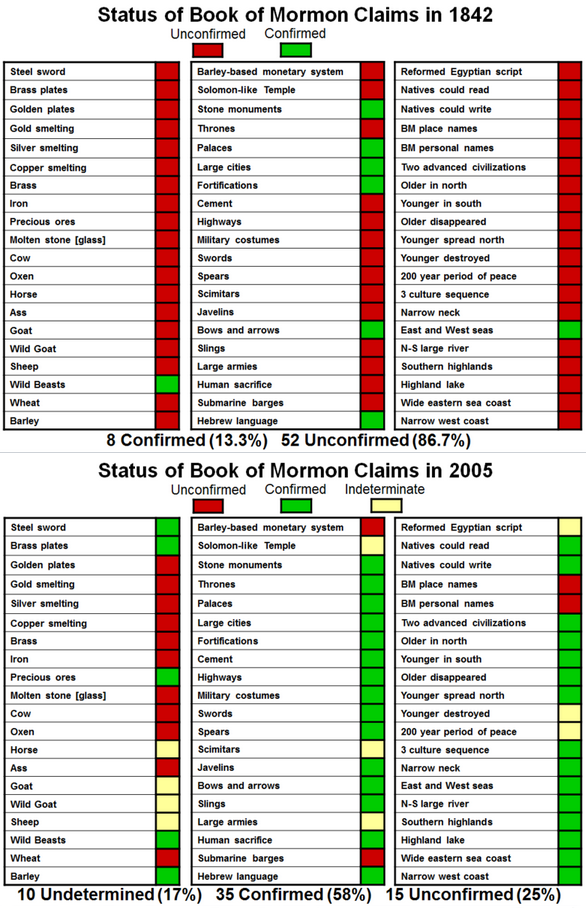
FairMormon deleted their above response. See screenshot.
Jeremy's Response to FairMormon
Contrary to FairMormon's 2005 chart, which is unsupported by sources, below is a corrected 2014 chart, supported by credible sources:
To access live hyperlink sources for the above chart, click here.
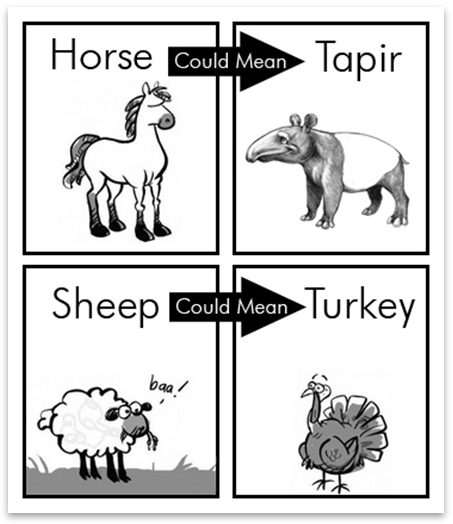
Aside from the specific anachronisms (which I discuss in detail below), the reality is that as "knowledge expands," it in fact provides more solid evidence against the Church's truth claims rather than for them.
Among the more significant examples are the DNA evidence described above, Egyptology and and the Book of Abraham, and the recently discovered similarities between the Late War and the Book of Mormon. Other examples include: the evidence against the existence of any global flood, Noah's Ark, or the Tower of Babel; the evidence of life, including Hominids, existing (and dying) before the alleged existence of Adam and Eve; and the evidence that the Earth has existed for billions of years (rather than the 7,000 stated in D&C 77). These events and claims are included in the Book of Mormon, other scriptures, and have been espoused by current and past "prophets, seers, and revelators" who have literally believed in the above scientifically disproven events.
Returning to Book of Mormon anachronisms, I find FairMormon’s response, “what was once an anachronism turns out to be a legitimate feature of the ancient world” to be disingenuous. Notice that FairMormon does not say “turns out to be a legitimate feature of ‘pre-Columbian Americas’ or ‘ancient Americas’ or ‘America during Book of Mormon times'.” “Ancient world” allows FairMormon to expand to anywhere in the world in any vague time period (“ancient” is not clearly defined) while leaving their Latter-day Saint readers to interpret “ancient world” to also mean pre-Columbian Americas.
Further, FairMormon makes these astounding claims without providing any sources in their response. FairMormon's claims and findings would shock and surprise non-Mormon archaeologists, anthropologists, linguists, and scientists.
Zoology, Metallurgy, Archaeology, Anthropology, Linguistics, and Biology are all branches of science domains which expand well beyond BYU. Where are FairMormon’s non-LDS sources? Peer-reviewed sources from respected people and organizations not tainted or clouded by religious confirmation bias? Sources from individuals whose careers, values, and contributions are not measured and valued by their ability to find any evidence – stretched or not – to confirm their own religion’s truth claims? After all, “it is difficult to get a man to understand something when his salary depends on his not understanding it.” In other words, never underestimate what the mind can rationalize when a career is at stake.
Looking at FairMormon’s 2005 charts, serious problems become apparent, such as:
- Steel swords have been discovered in pre-Columbus America? Where is FairMormon’s source? Such an extraordinary discovery would be of significant importance and interest to non-Mormon archaeologists, anthropologists, metallurgists, and other scientists.
- It strikes me as strange that FairMormon’s latest chart is dated 2005. Eight years ago. A lot can happen in 8 years - new discoveries and new evidences. Perhaps one reason why FairMormon continues to rely on the 2005 chart is due to an article published in the same year entitled "Out of Dust: Ancient Steel Sword Unearthed," in which the article made the false and incorrect claim that an ancient steel sword has been discovered. The Maxwell Institute had to release a new article in 2006 entitled "Out of the Dust: All That Glitters Is Not...Steel" admitting that no steel was found and thus retracting its claim.
- FairMormon’s original 1842 chart includes some items that required no investigation and ratification, such as “wild beasts,” “large cities,” and “fortifications,” because those items were widely known to have existed in ancient America when the Book of Mormon was produced. Similarly, “East and west seas” were never in question as the Church has taught the hemispheric model. This is just padding to add to the charts in order to boost up percentages. FairMormon likely included these items to increase the number of “Green” boxes. This strategy is very telling.
- The charts include many items which FairMormon knew to have been recently “discovered” or at least could be considered (by FairMormon) to be “undetermined” in order to reduce the number of "Red" boxes.
- Some of these “discoveries” relate only to civilizations in different times and places to the Book of Mormon and are not evidence for the Book of Mormon and its claims.
- Notably, wheat is still not “red” despite Book of Mormon claims that it was a Nephite staple used to feed millions of people. As explained by Dr. Michael Coe on this Mormon Stories podcast episode, had wheat existed in the Americas during Book of Mormon times, wheat pollen soil core samples would certainly be found by archaeologists. FairMormon offers no explanation as to why no soil core sample has ever resulted in any evidence of wheat.
- With respect to barley, a few obscure grains of a wild barley in Arizona does not equate to the domesticated variety supposedly taken from the Holy Land to the Americas and used to feed millions of people in the Book of Mormon setting. Such a pollen producing crop would have been evidenced long ago had it been a real aspect of early native American life anywhere. Nevertheless, this doesn’t stop Mormon apologists from coloring in the box green.
- The animals in FairMormon’s charts that were changed from “red” to “yellow” (the horse, goat, wild goat, and sheep) did not exist in the Americas during the Book of Mormon era. FairMormon does not provide any specific evidence or peer- reviewed data whatsoever to justify turning the red boxes into yellow for animals which respectable scientists and institutions agree did not exist in the Americas during Book of Mormon times.
- None of the metallurgy identified in FairMormon’s charts, such as steel, iron, brass, etc., existed in the pre-Columbian Americas. FairMormon does not provide any specific evidence or peer reviewed sources whatsoever to justify turning the red boxes for “steel sword” and “brass plates” into green.
- The charts show a couple of items—“human sacrifice” and “slings”—that have been discovered during the period between 1842 and 2005. Such discoveries are indeed evidence that archaeology has come a long way. However, these items do not support FairMormon’s argument, because the archaeological evidence suggests that these items existed outside the time period of the Book of Mormon.
- A major omission from FairMormon’s charts is the wheel. The Book of Mormon described chariots, which obviously required the use of a wheel. There were no wheels used for travel or transportation in pre-Columbian America.
- It’s unclear why FairMormon changed the “horse” item from red to yellow, but, to the extent FairMormon considers a tapir to satisfy this requirement, I’m sorry but that just won’t work. Tapirs do not pull chariots. Especially chariots without wheels. You may change that box back to red.
- Elephants? Not on the list? Elephants are an anachronism.
- Chariots? Not on the list? Anachronism.
- Silk? Not on the list? Anachronism.
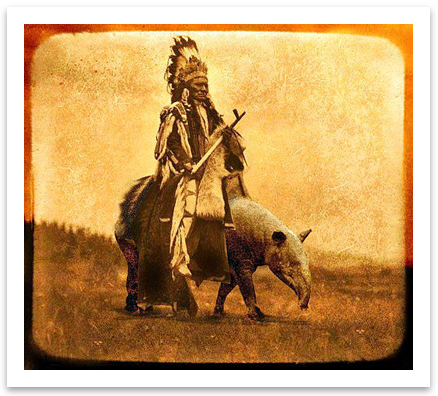
It’s a joke for FairMormon to not include all of the anachronisms in the list. But then again, when the sole purpose of your charts is to do all you can to boost and prop up green boxes and percentages? I’d be tempted to leave stuff out too.
FairMormon does not provide any evidence to back up its claim that anachronisms expire as “knowledge expands.” These charts are misleading. No peer reviewed sources or evidences or references or explanations on how each of the anachronisms went from red to green or from red to yellow. We’re just expected to trust the data of a Mormon archaeologist/anthropologist and part-time apologist who gives talks at FairMormon and writes reviews for the Neal A. Maxwell Institute?
The best evidence that FairMormon can give us is data from a Mormon archaeologist / anthropologist / apologist? But nothing from non-Mormon sources or institutions. No peer review by non-Mormon professors and respected scientific and archaeological institutions?
FairMormon might as well give us the following chart to support the Book of Mormon since FairMormon thinks providing evidences, sources, and non-LDS apologetic peer-reviewed data is overrated:
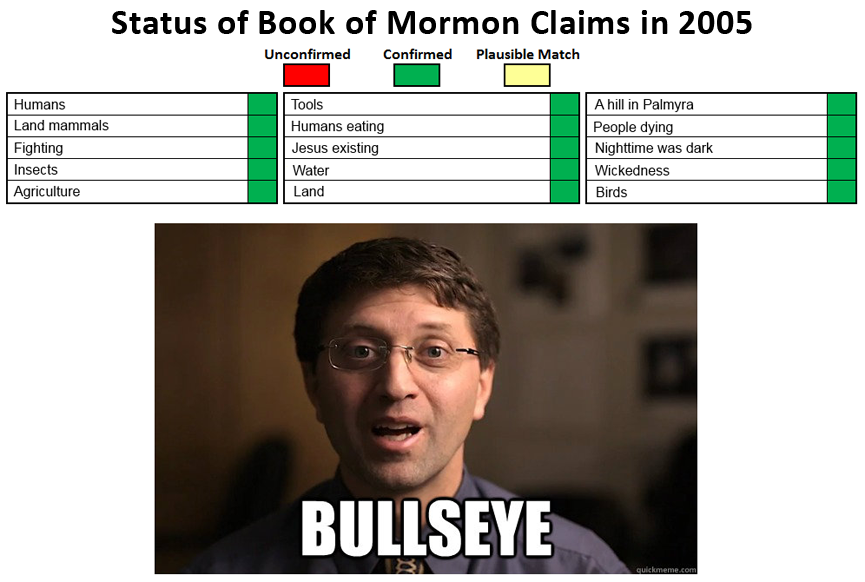
Above Chart/Image Credit: Reddit /u/bewilderedbear
Archaeology
"There is absolutely no archaeological evidence to directly support the Book of Mormon or the Nephites/Lamanites who numbered in the millions."
- It is a common claim by critics that there is “absolutely no archaeological evidence” to support the Book of Mormon.
FairMormon deleted their above response. See screenshot.
Jeremy's Response to FairMormon
Yes, critics like the Smithsonian Institute and the National Geographic Society. Two of some of the world’s most renowned, reputable, and respected scientific research and education institutions.
Here’s what the National Geographic Society has to say about the Book of Mormon, including claims that there’s archaeological support for the book:
National Geographic Statement on the Book of Mormon
Key National Geographic points from the letter:
- “Archaeologists and other scholars have long probed the hemisphere’s past, and the Society does not know of anything found so far that has substantiated the Book of Mormon.”
- “I have enclosed a statement issued by the Smithsonian Institution in 1982.”
Not only does National Geographic make it clear that there is no evidence to substantiate the Book of Mormon, it also gives its endorsement of the following Smithsonian Institute letter:
Smithsonian Institute Statement on the Book of Mormon
National Museum of Natural History Smithsonian Institution, Washington, D.C. 20560
Statement Regarding the Book of Mormon
- The Smithsonian Institution has never used the Book of Mormon in any way as a scientific guide. Smithsonian archaeologists see no direct connection between the archaeology of the New World and the subject matter of the book.
- The physical type of the American Indian is basically Mongoloid, being most closely related to that of the peoples of eastern, central, and northeastern Asia. Archaeological evidence indicates that the ancestors of the present Indians came into the New World -- probably over a land bridge known to have existed in the Bering Strait region during the last Ice Age -- in a continuing series of small migrations beginning from about 25,000 to 30,000 years ago.
- Present evidence indicates that the first people to reach this continent from the East were the Norsemen who briefly visited the northeastern part of North America around A.D. 1000 and then settled in Greenland. There is nothing to show that they reached Mexico or Central America.
- One of the main lines of evidence supporting the scientific finding that contacts with Old World civilizations, if indeed they occurred at all, were of very little significance for the development of American Indian civilizations, is the fact that none of the principal Old World domesticated food plants or animals (except the dog) occurred in the New World in pre-Columbian times. American Indians had no wheat, barley, oats, millet, rice, cattle, pigs, chickens, horses, donkeys, camels before 1492. (Camels and horses were in the Americas, along with the bison, mammoth, and mastodon, but all these animals became extinct around 10,000 B.C. at the time the early big game (sic) hunters spread across the Americas.)
- Iron, steel, glass, and silk were not used in the New World before 1492 (except for occasional use of unsmelted meteoric iron). Native copper was worked used (sic) in various locations in pre-Columbian times, but true metallurgy was limited to southern Mexico and the Andean region, where its occurrence in late prehistoric times involved gold, silver, copper, and their alloys, but not iron.
- There is a possibility that the spread of cultural traits across the Pacific to Mesoamerica and the northwestern coast of South America began several hundred years before the Christian era. However, any such inter-hemispheric contacts appear to have been the results of accidental voyages originating in eastern and southern Asia. It is by means certain that even such contacts occurred; certainly there were no contacts with the ancient Egyptians, Hebrews, or other peoples of Western Asia and the Near East.
- No reputable Egyptologist or other specialist on Old World archaeology, and no expert on New World prehistory, has discovered or confirmed any relationship between archaeological remains in Mexico and archaeological remains in Egypt.
- Reports of findings of ancient Egyptian, Hebrew, and other Old World writings in the New World in pre-Columbian contexts have frequently appeared in newspapers, magazines, and sensational books. None of these claims has stood up to examination by reputable scholars. No inscriptions using Old World forms of writing have been shown to have occurred in any part of the Americas before 1492 except for a few Norse rune stones which have been found in Greenland.
Scanned copy of the Smithsonian Institute letter can be found here.
In August 2013, a 17-year-old by the name of Zachary decided to email sixty college professors whose expertise was in one of the following fields: Pre-Columbian Mesoamerica Archaeology, Pre-Columbian Mesoamerica Anthropology, and Egyptology. Zachary sought their professional opinion on the historicity of the Book of Mormon and the Book of Abraham.
Out of the sixty college professors that Zachary emailed, 25 responded. Out of the 25 who responded, 14 gave permission to Zachary to publish their names and comments. The responses that Zachary received from these experts are fascinating. The overwhelming consensus from these unbiased experts in pre-Columbian America archaeology/anthropology and Egyptology is that neither the Book of Mormon nor the Book of Abraham is historical, factual, or congruent to the current and existing data and evidence.
The responses from these professors and experts can be read here.
In addition to the statements made by those professors, here are some more statements made by both LDS and non-LDS archaeologist and anthropologist individuals and organizations:
“So far as is known to the writer, no non-Mormon archaeologist at the present time is using the Book of Mormon as a guide in archaeological research. Nor does he know of any non-Mormon archaeologist who holds that the American Indians are descendants of the Jews, or that Christianity was known in America in the first century of our era...”
– Ulster Archaeological Society Newsletter, no. 64, Jan. 30, 1960, p. 3
"With the exception of Latter-day Saint archaeologists, members of the archaeological profession do not, and never have, espoused the Book of Mormon in any sense of which I am aware. Non-Mormon archaeologists do not allow the Book of Mormon any place whatever in their reconstruction of the early history of the New World.”
– Ulster Archaeological Society Newsletter, no. 64, Jan. 30, 1960, p.3
“Let me know state categorically that as far as I know there is not one professionally trained archaeologist, who is not a Mormon, who sees any scientific justification for believing the foregoing to be true, ... nothing, absolutely nothing, has ever shown up in any New World excavation which would suggest to a dispassionate observer that the Book of Mormon... is a historical document relating to the history of early migrants to our hemisphere.”
– Michael Coe, Dialogue: A Journal of Mormon Thought, Summer 1973, pp. 42, 46
"The first myth we need to eliminate is that Book of Mormon archaeology exists…. If one is to study Book of Mormon archaeology, then one must have a corpus of data with which to deal. We do not. The Book of Mormon is really there so one can have Book of Mormon studies, and archaeology is really there so one can study archaeology, but the two are not wed. At least they are not wed in reality since no Book of Mormon location is known with reference to modern topography. Biblical archaeology can be studied because we do know where Jerusalem and Jericho were and are, but we do not know where Zarahemla and Bountiful (nor any other location for that matter) were or are. It would seem then that a concentration on geography should be the first order of business, but we have already seen that twenty years of such an approach has left us empty-handed."
– Dee F. Green, Mormon archaeologist, Dialogue: A Journal of Mormon Thought, Summer 1969, pp. 77-78
“I’m afraid that up to this point, I must agree with Dee Green, who has told us that to date there is no Book of Mormon geography.... you can’t set Book of Mormon geography down anywhere – because it is fictional and will never meet the requirements of the dirt-archaeology.”
– Thomas S. Ferguson, Mormon archaeologist, “Letter to Mr. and Mrs. H.W. Lawrence,” dated Feb. 20, 1976
“While some people chose to make claims for the Book of Mormon through archaeological evidences, to me they are made prematurely, and without sufficient knowledge. I do not support the books written on this subject including The Messiah in Ancient America, or any other. I believe that the authors are making cases out of too little evidences and do not adequately address the problems that archaeology and the Book of Mormon present. I would feel terribly embarrassed if anyone sent a copy of any book written on the subject to the National Museum of Natural History – Smithsonian Institution, or other authority, making claims that cannot as yet be substantiated.... there are very severe problems in this field in trying to make correlations with the scriptures. Speculation, such as practiced so far by Mormon authors has not given church members credibility.”
– Ray T. Matheny, Mormon scholar and BYU professor of anthropology, letter dated Dec. 17, 1987
“In my recent reading of the Book of Mormon, I find that iron and steel are mentioned in sufficient context to suggest that there was a ferrous industry here.... You can’t refine ore without leaving a bloom of some kind or impurities that blossom out and float to the top of the ore... and also the flux of limestone or whatever is used to flux the material.... [This] blooms off into silicas and indestructible new rock forms. In other words, when you have a ferroused metallurgical industry, you have these evidences of the detritus that is left over. You also have the fuels, you have the furnaces, you have whatever technologies that were there performing these tasks; they leave solid evidences. And they are indestructible things.... No evidence has been found in the new world for a ferrous metallurgical industry dating to pre-Columbian times. And so this is a king-size kind of problem, it seems to me, for the so-called Book of Mormon archaeology. This evidence is absent.”
– Ray T. Matheny, Speech at Sunstone Symposium 6, "Book of Mormon Archaeology," August 25, 1984
“I haven’t changed my views about the Book of Mormon since my 1973 article. I have seen no archaeological evidence before or since that date which would convince me that it is anything but a fanciful creation by an unusually gifted individual living in upstate New York in the early nineteenth century.”
– Dr. Michael Coe, correspondence between Bill McKeever and Michael Coe
Dr. Michael Coe, archaeologist and expert on the Maya and Central American archaeology, gave an outstanding interview recently regarding the problems and challenges that Limited Geography Model apologists such as FairMormon face in light of archaeological evidence in Central and South America, where the Limited Geography Model setting is claimed to be.
To objective archaeologists and scientists outside of Mormonism, the Book of Mormon has as much historic validity and utility as The Hobbit.
Where are all the bones, swords, armor, shields, helmets, and spears from these epic battles claimed in the Book of Mormon? Epic battles that took place at the Hill Cumorah (Rama to Jaredites)? The Jaredite nation supposedly ended there with 2,000,000 men slain. The Nephites and Lamanites also had a battle there in 421 AD where 230,000 warriors with weapons of steel were killed.
Why has not a single sword, helmet, shield, spear, armor and yes, bone, been found from one of these great ancient battle sites?
Contrast this remarkable lack of evidence for the Book of Mormon with the 1974 discovery of the Terracotta Warriors and Horses near Xian, China. This amazing army of some 8,000 Terracotta figures was buried in 210 BC, some 600 years before the purported final battle in the Book of Mormon. Surely, if there was battle at Cumorah in 421 AD which involved 230,000 men, there would be something to be found, but there isn’t. The year 421 AD, in archaeological and anthropological terms, is simply not that long ago.
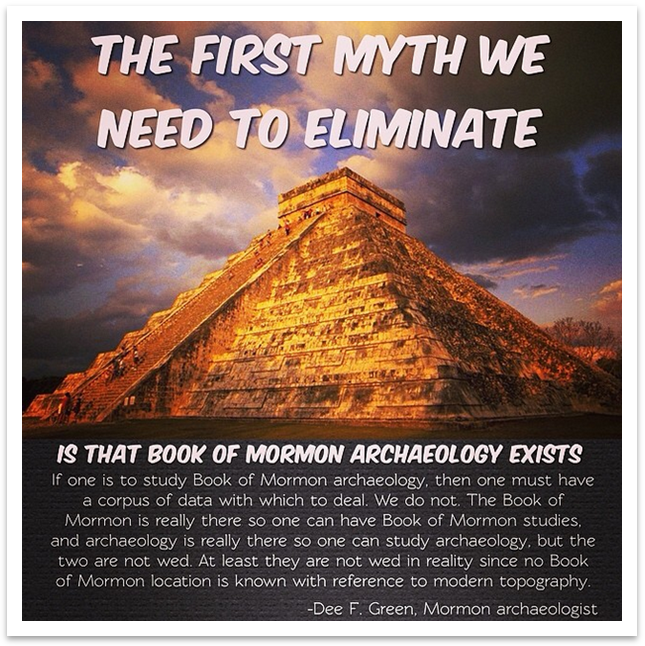
- When they say “directly” support, they typically mean that they are looking for a direct corroboration, such as the presence of the name “Nephi” or “Zarahemla” in association with ancient American archaeological data.
FairMormon deleted their above response. See screenshot.
Jeremy's Response to FairMormon
FairMormon is putting words in the mouths of critics. When critics state that there is absolutely no evidence to directly support the Book of Mormon or the Nephites/Lamanites who numbered in the millions, they’re saying:
“There is no location that matches multiple items/technology/animals that the Book of Mormon states should be found in the time period specified. Examples of these items/technology/animals would be gold, steel, swords, horses, wheat, elephants, etc. Scientists are not necessarily just looking for names of people or places that are similar to ones in the Book of Mormon – just evidence of a culture that matches Book of Mormon claims.”
If the Book of Mormon is historical and the geography, for example, is real, then it is not unreasonable for Mormon scholars to put together – based on the data – of a potential location of one single Book of Mormon land. It is not unreasonable to then publish for peer-review this data in a non-Mormon journal that is not BYU-controlled. It is not unreasonable to have other archaeologists, anthropologists, and other experts to peer review the data. This is the scientific process which was used to find the lost city of Troy. This is the same scientific process that can lead to the discovery of Zarahemla. Unfortunately for the Church and its apologists, decades of vigorous archaeological and anthropological research has yielded nothing. This is also the same scientific process that was used to find the thousand-year-old Viking outpost in Canada. Quite frankly, it is beyond ridiculous that we can find a tiny Viking outpost in Canada which consisted of people who landed a thousand years ago in a very remote part of the Americas but we cannot find a trace of a massive Nephite/Lamanite civilization which numbered in the millions. It’s insane that a civilization roughly the size of the Roman Empire, spanning a time frame of 1,000 years, just completely vanished into thin air without a trace. The Romans left roads, aqueducts, coins, buildings, independent historical accounts, etc. all over Europe and the Mediterranean.
Where is the evidence for the Nephite and Lamanite civilizations?
- There is plenty of supporting evidence that anthropologically ties the Book of Mormon to ancient America.
FairMormon deleted their above response. See screenshot.
Jeremy's Response to FairMormon
This is a false claim. There is not “plenty of supporting evidence that anthropologically ties the Book of Mormon to ancient America.” Notice that FairMormon does not offer any sources to this “plenty of supporting evidence.”
If there was really “plenty of supporting evidence,” there wouldn’t be letters from reputable institutions such as the Smithsonian Institute and National Geographic Society dismissing the Book of Mormon as an unhistorical record.
This goes back to the charts that FairMormon used in the Anachronism section: zero evidence, zero sources, and zero non-Mormon/non-BYU peer-reviewed data.
“Critical questions. Faithful answers.” Indeed.
A detailed list of the Book of Mormon archaeology problems can be found here and here.
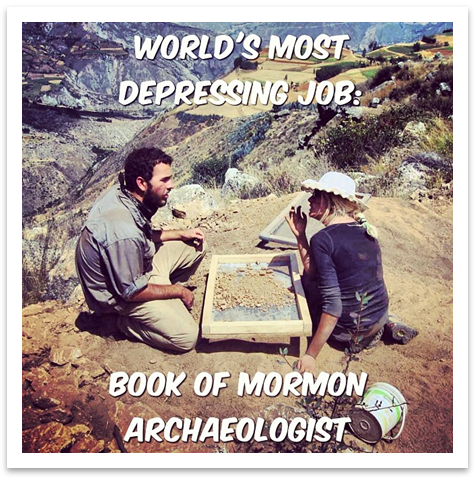
Book of Mormon Geography
The document claims "Many Book of Mormon names and places are strikingly similar to many local names and places of the region Joseph Smith lived."
- Incorrect:
Out of 345 Book of Mormon names, the list of 28 presented by the author is seriously reduced when one eliminates the Biblical names and those which did not exist on any map at the time that the Book of Mormon was published.
FairMormon deleted their above response. See screenshot.
Jeremy's Response to FairMormon
I address FairMormon's attack on the 28 geographical names below.
Before I get to those, however, I’d like to discuss additional evidence of similarities between the “345 Book of Mormon names” and a contemporaneous book available in Joseph’s time and backyard. Aside from FairMormon not sharing that many, if not most, of the “345 Book of Mormon names” are also biblical names, many of the names unique to the Book of Mormon are…well, not so unique.
There was a book published in 1791 by John Walker entitled, A Key to the Classical Pronunciation of Greek, Latin, and Scripture Proper Names. In this book are a number of future Book of Mormon names, which appeared within alphabetized lists. This book was a common household reference in young Joseph Smith’s time and place. According to Larry Porter, “Walker’s Dictionary” was suggested for the curriculum in the Colesville, New York schools by the local commissioners in the fall of 1826.


This link does a side by side comparison between Book of Mormon names and Walker's Key Dictionary.
- Mutually exclusive claims:
The author, in the next section, presumes that the name “Moroni” was derived from the capital city of the Comoros Islands, or from “treasure stories” about Captain Kidd. In this section, he asserts that the name “Moroni” is derived from the town “Monroe, New York,” which was founded in 1818.
FairMormon deleted their above response. See screenshot.
Jeremy's Response to FairMormon
I agree with FairMormon. It was an oversight on my part to include Holley’s “Monroe = Moroni” claim, which I do not agree with. I removed Holley’s “Monroe = Moroni” claim.
I stand by my assertion that Joseph Smith derived “Camorah” and “Moroni” from Captain Kidd stories, which included adventures on what is now known as the Comoros Islands, as I detailed in the CES Letter and which I expand further below in the Hill Cumorah section.
Of course, FairMormon never engages in mutually-exclusive claim-making. For example, there is no conflict with Joseph translating the Book of Mormon by putting his face to a darkened hat and reading the words, as they appear in English on the seer stone, and spelling out names he could not pronounce...while simultaneously claiming that the KJV Bible errors in the Book of Mormon is easily explained by Joseph simply using the Bible to help with the translation.
- The Book of Mormon contains 345 names. The theory that the author is relying on, proposed by Vernal Holley and posted by Mazeministries, is that 28 of these names were derived by Joseph Smith by looking at the names of places in the surrounding region, then altering the names slightly to create a map of Book of Mormon lands. The original map of which the author obtained this information included names of places which didn’t even exist in Joseph Smith’s time. The map used in “Letter to a CES Director” is a derivative of the Holley map which no longer includes those names, however, the list of names used by the author still includes quite a few of these.
- The author lists the following correspondences. In order to obtain this list of parallels, a huge geographical area must be scanned. Five states and two Canadian provinces yield this list of parallels, and it gets even smaller when one actually tries to locate many of these places on a map. In the list below.
- Names in red indicate places which either did not have that name until after 1830, or cannot be found on a map or in the Book of Mormon.
- Names in blue indicate names that are found in the Bible.
- Names in green indicate names that could potentially be a valid match.
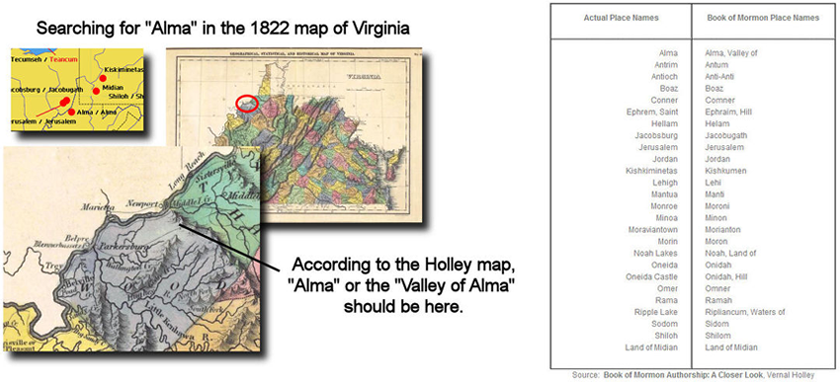
FairMormon deleted their above response. See screenshot.
Jeremy's Response to FairMormon
Before we go over each one of the towns/cities, I want to illustrate an important concept:
In the 1980s, I lived in Diamond Bar, California. In the early 20th century, it was known as “Diamond Bar Ranch,” and it was at the time one of the largest working cattle ranches in the western United States. In the 1950s, it was acquired by Transamerica Corporation for the purpose of developing one of the nation’s first master-planned communities. It was after Transamerica’s acquisition that it gave the “Diamond Bar” name to its new master-planned community.
So what does this mean for this discussion? Fast forward into the distant future, 150 years from now. The only information that you have about Diamond Bar is that it was a city in California and that it was incorporated as a city on April 18, 1989. Your first natural assumption would be that prior to 1989, Diamond Bar didn’t exist, at least not under the name “Diamond Bar.” However, this assumption would be false, as the name goes back to the early 20th century, as I explained above.
One of FairMormon’s strategies and arguments for many of the names was to pull in the dates from Wikipedia and other sources of when the towns were incorporated so as to say, “See?! This town wasn’t incorporated until so-and-so, which is so-and-so years after the publication of the Book of Mormon!” The problem with this strategy and approach is that the date of incorporation does not always mean that the town and its name did not exist for decades before its incorporation, as was the case of Diamond Bar.
Here are more examples of Date Settled vs. Incorporated as a Town/City, this one focused on towns in the Commonwealth of Massachusetts. Notice the gap between settlement and incorporation dates of some of the towns are 100+ years.
Another important note I want to make here is that Vernal Holley is dead. We can’t contact him to find out exactly where he got his sources. FairMormon’s strawman that these towns/cities were discovered only through maps may not be FairMormon as to how Holley found some of the towns. He may have used letters, newspapers, post office records, obituaries, local city/county library records, etc. in which records and books are not accessible online. We do not know.
This is evident in the "Jerusalem" claim. FairMormon claims that Jerusalem, Ohio does not show up on a 1822 map. If one searches on the internet for when Jerusalem was first settled, they won't find any information. So, the logical conclusion would be to assume that Jerusalem wasn't established before the publication of the Book of Mormon. However, this would be incorrect as there is evidence that the first house in Jerusalem, Ohio was built in 1825. I was able to locate a resident who volunteered to go to the Monroe County Public Library in Woodsfield, Ohio and search for the information. She found it an offline book entitled Monroe County, Ohio: A History. Simply doing a Google search may not show the whole picture. There are still numerous local books and records that are hidden offline awaiting digitization.
Below I list each town, provide FairMormon's criticism, and then offer a response to FairMormon's criticism.
Alma = Alma, Valley of
FairMormon: Alma. In the area indicated on the Holley map, modern maps show that there is a small, unincorporated community called Centerville, also known as Alma, in Tyler County, West Virginia, United States. Coordinates: 39°25′55″N 80°50′24″W. However, when we view the 1822 map of Virginia, we cannot find the name “Alma” anywhere.
Response: I agree with FairMormon that the Holley map incorrectly depicts Alma as being in West Virginia. Upon further research, I discovered Alma, New York, which was first settled “around 1833.”
As mentioned above, names of towns and cities were often known to locals before the area was first or completely settled and incorporated. Many times as early as several decades.
I corrected the map I included in the CES Letter to reflect the location of Alma, New York.
It’s interesting to note that the folks at FairMormon never bothered to mention Alma, New York, which I presume they came across in their research (I found it quickly and easily in a Google search), but FairMormon fails to bring this fact to the attention of their readers.
Antrim = Antum
FairMormon: Antrim = Antum. “Antrim Township” is located in Franklin County, Pennsylvania. It was named after County Antrim in Northern Ireland. The township was organized in 1741.
Response: This is correct.
Antioch = Anti-Anti
FairMormon: Antioch = Anti-Anti. The name “Anti-Anti” doesn’t even appear in the Book of Mormon, nor does the biblical name “Antioch.”
Response: Anti-Anti is a misspelling of “Ani-Anti,” which is found in Alma 21:11.
And, yes, the name “Antioch” is in the Bible, but that’s beside the point. The fact that it also existed as a geographical place in Joseph’s time and place and in a setting that Joseph taught early on to be the geographical site of the Book of Mormon is the point.
Boaz = Boaz
FairMormon: Boaz = Boaz. The name “Boaz” is from the Bible. Joseph would not have needed to look at a map for this one, unless one accepts Holley’s assertion that the Holley map is supposed to show the geographical locations of Book of Mormon places.
Response: Unlike the use of the name “Boaz” in the Bible, Joseph used the name “Boaz” as a geographical location in the Book of Mormon. The name “Boaz” in the Bible refers to the name of a character in the Book of Ruth.
Conner = Comner
FairMormon: Connor = Comner. The name “Comner” doesn’t appear in the Book of Mormon. The name “Comnor” does, in Ether 14:28. Of course, “Comnor” doesn’t match “Conner” quite as closely in spelling. We cannot find “Connor” in either New York or Pennsylvania.
Response: I agree with FairMormon that this similarity is relatively weak, and I have therefore removed this name from the list.
Ephrem, Saint = Ephraim, Hill
FairMormon: Ephrem, Saint = Ephraim, Hill. The actual name is "Saint-Éphrem-de-Beauce, Quebec." Wikipedia shows the town being established with that name in 1866. This is 36 years after the publication of the Book of Mormon. The Book of Mormon name "Ephraim," of course, is easily found in the Bible.
Response: I agree with FairMormon that this similarity is relatively weak, and I have therefore removed this name from the list and map.
Hellam = Helam
FairMormon: Hellam = Helam. According to the town’s website, Hellam Township, Pennsylvania, was established in 1739.
Response: This is correct.
Jacobsburg = Jacobugath
FairMormon: Jacobsburg = Jacobugath. Jacobsburg, Belmont Co., Ohio does not even show up on a 1822 map of Ohio.
Response: Here is what Wikipedia states about Jacobsburg, Ohio: “In 1833, Jacobsburg contained one tavern, two stores, a physician, sundry mechanics, and about 120 inhabitants.”
I find it interesting that FairMormon chose to ignore this evidence. Instead, FairMormon points to a map as early as 1822 claiming that the city must not have existed as it’s not on an 1822 map. Never mind that the city could have been built after 1822 but before the publication of the Book of Mormon.
The fact that the city was already well up and running with two stores, a tavern, sundry mechanics, a physician, and 120 inhabitants by 1833 shows that it likely existed before 1830.
Jerusalem = Jerusalem
FairMormon: Jerusalem = Jerusalem. Jerusalem, Monroe Co., Ohio does not even show up on a 1822 map of Ohio. Even today the village of Jerusalem occupies only 0.2 square miles. Besides, the name "Jerusalem" is from the Bible. Joseph would not have needed to look at a map for this one, unless one accepts Holley's assertion that the Holley map is supposed to show the geographical locations of Book of Mormon places.
Response: The first house in Jerusalem, Ohio was built in 1825, which explains why it wouldn’t appear on an 1822 map of Ohio.
And yes, it was in the Bible, but that's beside the point. The fact that it also existed as a geographical place in Joseph’s time and place and in a setting that Joseph taught early on to be the geographical site of the Book of Mormon is the point.
Jordan = Jordan
FairMormon: Jordan = Jordan. The name "Jordan" is from the Bible. Joseph would not have needed to look at a map for this one, unless one accepts Holley's assertion that the Holley map is supposed to show the geographical locations of Book of Mormon places.
Response: Again, yes it was in the Bible. That’s beside the point. The fact that it also existed as a geographical place in Joseph’s time and place and in a setting that Joseph taught early on to be the geographical site of the Book of Mormon is the point.
Kishkiminetas = Kishkumen
FairMormon: Kishkiminetas = Kishkumen. Kishkiminetas Township, Armstrong County, Pennsylvania was given that name in 1832, two years after the Book of Mormon was published. From History of Armstrong County Pennsylvania, written in 1883 by Robert Walter Smith, "The petition of sundry inhabitants of Allegheny township was presented December 22, 1831, to the court of quarter sessions of this county, asking that a new township be formed out of the upper end of Allegheny township, to be called Kiskiminetas. Philip Klingensmith, John Lafferty and John McKissen were appointed viewers, who, after one continuance of their order, presented their report recommending the organization of the new township, which was approved by the court June 19, 1832." Kiskiminetas River in Pennsylvania does exist prior to the town, and one would assume that it would show up on a map. The Holley map, however, does not indicate that Kishkiminetas is a river, but rather a place.
Response: The point that matters is that the name “Kishkiminetas” existed and was known in Joseph’s time and backyard before the publication of the Book of Mormon. It was and is the name of a 27-mile river.
Lehigh = Lehi
FairMormon: Lehigh = Lehi. There is indeed a “Lehigh Valley” located in Pennsylvania.
Response: This is correct.
Mantua = Manti
FairMormon: Mantua = Manti. According to the town’s website, Mantua Village, Ohio was incorporated in 1898. This is 68 years after the publication of the Book of Mormon.
Response: FairMormon is being deceptive here. Here is what Mantua Village’s website says exactly (most of which FairMormon omits from their readers):
“A Little History: Mantua Village (pronounced, "MAN-a-way") is located along the Cuyahoga River (known by native inhabitants as the "Crooked River") in Portage County. From its humble beginnings in the early 1800s, with its railroad station, 13 saloons, house of "ill repute" and a shipping point for area farmers, Mantua Village was formed and quickly began to grow. A Post Office was established in 1860 and the Village was incorporated in 1898.”
FairMormon is misleading their readers into thinking that the town and its name did not exist before 1898, which is false. The town and its name existed, as mentioned on the town’s own website, in the “early 1800s.”
As I’ve demonstrated previously, a town and its name can exist for many decades before its official incorporation. Mantua is another example of this.
Monroe = Moroni
FairMormon: Monroe = Moroni. The author, in the next section, presumes that the name "Moroni" was derived from the capital city of the Comoros Islands, or from "treasure stories" about Captain Kidd. There is a town "Monroe, New York" which was founded in 1818.
Response: FairMormon is correct. As mentioned previously, this was an honest oversight on my part. I do not believe that Moroni came from Monroe. As I mentioned in the Hill Cumorah section, I believe "Moroni" and “Camorah” are derived from Captain Kidd stories. I removed “Monroe = Moroni.”
Minoa = Minon
FairMormon: Minoa = Minon. According to the Minoa town website, the town of Minoa, New York received that name in 1895. That is 60 years after the Book of Mormon was published.
Response: I agree with FairMormon. The town’s website specifically states that the name changed in 1895. I have removed Holley’s error from the list.
Moraviantown = Morianton
FairMormon: Moraviantown = Morianton. Moravian Indian Reserve No. 47, Ontario, appears to have been established in 1782.
Response: Correct.
Morin = Moron
FairMormon: Morin = Moron. According to Wikipedia, Morin Township, Quebec, was formed in 1852. This would be 22 years after the Book of Mormon was published.
Response: I agree with FairMormon. Wikipedia is specific that Morin was first settled in 1850. I removed Holley’s error from the list and map.
Noah Lakes = Noah, Land of
FairMormon: Noah Lakes = Noah, Land of. The name "Noah" is from the Bible. Joseph would not have needed to look at a map for this one, unless one accepts Holley's assertion that the Holley map is supposed to show the geographical locations of Book of Mormon places.
Response: Yes, it was in the Bible but that’s beside the point. The fact that it also existed as a geographical place in Joseph’s time and place and in a setting that Joseph taught early on to be the geographical site of the Book of Mormon is the point.
Oneida = Onidah
FairMormon: Oneida = Onidah. See “Oneida Castle” below.
Oneida Castle = Onidah Hill
FairMormon: Oneida Castle = Onidah, Hill. Oneida Castle, New York is located at 43°4′42″N 75°38′0″W. The Town has existed since the 18th century.
Response: This is correct.
Omer = Omner
FairMormon: Omer = Omner. We cannot find "Omer" on any modern map of Pennsylvania, New York or Canada.
Response: I agree with FairMormon and have removed Holley's claim from the list.
Rama = Ramah
FairMormon: Rama = Ramah. Rama Township, Ontario, was "first surveyed in 1834."[1] This is four years after the publication of the Book of Mormon.
Response: This is a great case study of FairMormon disingenuity.
First of all, notice how FairMormon provides their source for this. They put a footnote “1” that links to their “Endnotes” section on the bottom as opposed to just directly linking to the website as FairMormon has for other sources, such as town websites, Wikipedia, and the maps.
Also notice that FairMormon does not put a page number in their source at the bottom in the “Endnotes.” There is a reason for this. Here is what it actually says in the source:
“The fact that Rama Township grew in fits and starts is reflected in the piecemeal fashion it was surveyed into settlement lots. One third of the township – the west side, bordering Lake Couchiching – was surveyed in 1834 by William Keating.” (Emphasis added)
Isn’t that interesting? This is quite different from FairMormon’s “first surveyed in 1834” claim, isn’t it? There’s a difference between “one third of the township – the west side” being surveyed in 1834 versus the entire town “first” being surveyed in 1834.
Further, here’s the most important part from page 8 that FairMormon decided to omit from their readers:
“The name Rama was already used for the area in 1826, when the Black River was first surveyed.”
So, FairMormon is incorrect in their claim about Rama. The name was already being used for the area in 1826; several years before the publication of the Book of Mormon.
FairMormon has lost significant credibility here. If FairMormon were a witness on the stand, any lawyer worth his/her salt would have had a heyday impeaching FairMormon over this deception.
Ripple Lake = Ripliancum, Waters of
FairMormon: Ripple Lake = Ripliancum, Waters of. Ripple Lake is so small that it is difficult to locate on modern day maps, and it is one of more than 250,000 lakes in Ontario. Are we to assume that Joseph selected this one location amongst many, and then converted the name “Ripple Lake” to “Ripliancum”.
Response: As with the Hill Cumorah section below, FairMormon creates a strawman, contending that Joseph used only maps. FairMormon completely ignores that Joseph didn’t grow up in a vacuum and that he lived in a transient area in which many people come and went from all over.
By FairMormon’s logic, it’s impossible for Joseph to have derived “Moroni” and “Camorah” because the Comoros Islands is difficult to find on maps and is remote. Therefore, Joseph couldn’t have learned of the names from the Comoros Islands. Never mind that Joseph was a fan and a reader of Captain Kidd stories, which included adventures on the Comoros Islands.
FairMormon sets up a strawman by focusing only on maps while ignoring the fact that Joseph & Co. very well could have learned about the names from non-map sources.
I’ll leave to the reader to form their own opinion as to whether the name “Waters of Ripliancum” may have been derived from “Ripple Lake.”
Sodom = Sidom
FairMormon: Sodom = Sidom. The name "Sodom," of course, is well known from the Bible. Joseph would not have needed to look at a map for this one, unless one accepts Holley's assertion that the Holley map is supposed to show the geographical locations of Book of Mormon places.
Response: Of course it was in the Bible. That’s beside the point. The fact that it also existed as a geographical place in Joseph’s time and place and in a setting that Joseph taught early on to be the geographical site of the Book of Mormon is the point.
Shiloh = Shilom
FairMormon: Shiloh = Shilom. The name "Shiloh” is a biblical name. There is a Shiloh, Pennsylvania on modern maps.
Response: Again, the fact that the name “Shiloh” is in the Bible is beside the point. The fact that it also existed as a geographical place in Joseph’s time and place and in a setting that Joseph taught early on to be the geographical site of the Book of Mormon is the point.
Land of Midian = Land of Midian
FairMormon: Land of Midian = Land of Midian. The name "Land of Midian" is from the Bible and it is located in Egypt. Joseph would not have needed to look at a map for this one, unless one accepts Holley's assertion that the Holley map is supposed to show the geographical locations of Book of Mormon places. We are unable to locate a "Midian" or "Land of Midian" on any modern map of Pennsylvania.
Response: I agree with FairMormon and have removed Holley's claim.
The author claims "Many Book of Mormon names and places are strikingly similar to many local names and places of the region Joseph Smith lived," and "We read in the Book of Mormon of the Land of Desolation named for a warrior named Teancum who helped General Moroni fight in the Land of Desolation. In Smith’s era, an Indian Chief named Tecumseh fought and died near the narrow neck of land helping the British in the War of 1812. Today, the city Tecumseh (near the narrow neck of land) is named after him."
- The author is not only stating that the names are similar to those in the Book of Mormon, but also that the location of those names is similar (the references the author makes to the "narrow neck," for example). He does, after all, title this section "Book of Mormon Geography." In addition, since some of these names could have easily been taken from the Bible instead of the surrounding region, one must assume that their inclusion on the map also implies that their geographical locations relative to one another are important.
- Incorrect:
Looking at the geography, it is clear from Holley’s map that a number of locations have been selected to make the names match the existing geography. Some examples:
- The map places Jacobugath, site of “King Jacob’s” dissenters far in the land southward, when the Book of Mormon has it far in the land northward (3 Nephi 7:9-12; see also 3 Nephi 9:9).
- The map places the land of first inheritance [land of Lehi-Nephi] is on the eastern coast of the United States, while the Book of Mormon is clear that Lehi and his group landed on the western coast.
- The city of Morianton should be by the eastern seashore, near the city of Lehi (Alma 50:25).
- "Ramah” is the Jaredite name for the Hill Cumorah (Ether 15:11). The Hill Cumorah is not in Canada.
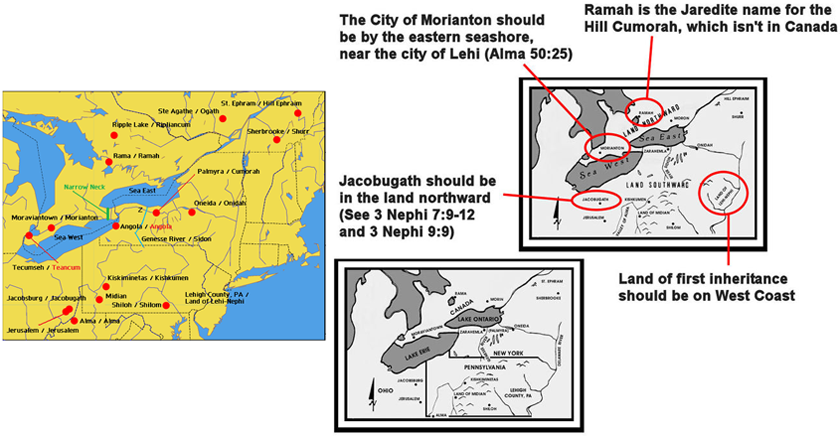
FairMormon deleted their above response. See screenshot.
Jeremy's Response to FairMormon
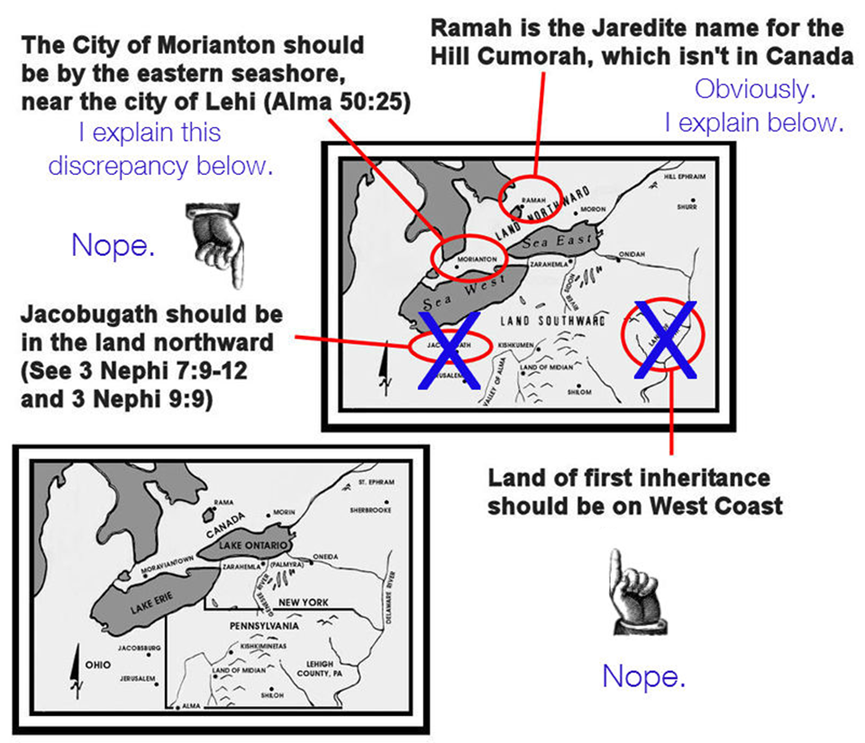
- “The map places Jacobugath, site of "King Jacob's" dissenters far in the land southward, when the Book of Mormon has it far in the land northward (3 Nephi 7:9-12; see also 3 Nephi 9:9).”
FairMormon is adding words to Book of Mormon that don’t exist. The only geographical reference to “Jacobugath” is that it is in the: “northernmost part of the land.” It does not say what land, and there is no universally acknowledged “land.” For FairMormon to assume that “northernmost” must mean that it’s the most north on this map in my letter is really reaching for something.
If I were in St. George, Utah, and I said I was going to the “northernmost part of the land,” you would not know whether I was going to the “northernmost” part of St. George or if I was going all the way up to the Utah/Idaho border or if I was going all the way to the United States/Canadian border. It depends on what “land” means. We do not know what “land” in this scripture refers to. - “The map places the land of first inheritance [land of Lehi-Nephi] is on the eastern coast of the United States, while the Book of Mormon is clear that Lehi and his group landed on the western coast.”
Actually, the Book of Mormon isn’t clear on this point. Notice that FairMormon fails to offer any source for their claim that Lehi and his group “landed on the western coast.” The reason why FairMormon fails to offer any source, as they did for “Jacobugath” and “Morianton,” is because FairMormon knows that the Book of Mormon does not say which coast Lehi & Co. landed. Further, FairMormon fails to tell their readers that there’s actually controversy within LDS apologetic circles as to which coast Lehi & Co. landed. I find it disingenuous, to say the least, that FairMormon tries to present this as factual to their readers when they know it is not factual.
FairMormon makes this claim on the assumption that LDS apologist Hugh B. Nibley was right in his premise that the “land of Bountiful” was on the coast in the Middle East and that Lehi & Co. didn’t sail around Africa but rather through the Pacific. This is just opinion as the Book of Mormon is silent on which coast Lehi & Co. landed.
Here is an LDS apologist making the argument that Lehi & Co. went the Atlantic ocean route.
And here's the pro-LDS Meridian magazine also making the case that Lehi & Co. sailed across the Atlantic ocean.
So, there is no consensus, evidence, or support for FairMormon’s assumption that Lehi & Co. landed on the Pacific coast.
Therefore, FairMormon’s claim that Lehi-Nephi is inaccurately placed on the map is unsupported. - “The City of Morianton should be by the eastern seashore, near the city of Lehi (Alma 50:25).”
Neither is Hill Cumorah in New York, according to the “Limited Geography Model” espoused by both FairMormon and the Neal Maxwell Institute. Never mind that Joseph Smith and “prophets, seers, and revelators” have taught it’s in New York. Never mind that Joseph Smith was, in turn, taught about the Book of Mormon civilizations by an angelic Moroni who himself deposited the plates in Hill Cumorah. Never mind that the Church still holds Hill Cumorah pageants there today.
Unofficial apologists have to invent another Cumorah to try to make the dots line up. Yet, the dots aren’t lining up. As long as this is the standard required, then having Ramah show up in the wrong place by a couple hundred miles isn’t a big deal.
Complaining that Ramah and Morianton are in the “wrong place” on a map is an argument given by minds that believe the Book of Mormon names are real places. On the flip side of this same coin, a critic might say “Joseph & Co. made a mistake and didn’t watch the geography carefully.”
Here’s the point that unofficial apologists and the “Joseph made a mistake and didn’t watch his geography” critics fail to grasp: the point of the map is not whether or not it matches exactly. The point is that it matches mostly. There are a striking number of names around the location in which Joseph Smith grew up, similar versions of which are in the Book of Mormon. Moreover, many of these similar place names are also situated in a geographically similar manner to which they are situated in the Book of Mormon. The coincidence is simply too great to ignore.
The maps do not have to match perfectly or even have to make sense. It’s like pointing out that Lord of the Rings’ Minas Tirith didn’t have enough farmland to support itself. Yes, Minas Tirith is a made up location. Getting it wrong in a fictional book is an indication it is fiction. Ramah being in Canada and being the name “Cumorah” in Jaradite just might be an indication that Joseph & Co. made stuff up.
Lord of the Rings J. R. R. Tolkien based his Middle Earth on locations around him at the time of his writings but he changed names and the map so that it would be “his own world.” An exact match isn’t necessary.
We see this modus operandi of plagiarism from Joseph Smith in the Book of Abraham where he copied completely independent and unrelated hieroglyphics from one different papyrus to fill in the damaged section of Facsimile 2. He then gives completely inaccurate translations that he presumably pulled from his imagination. Even FairMormon concedes that Joseph copied the hieroglyphics.
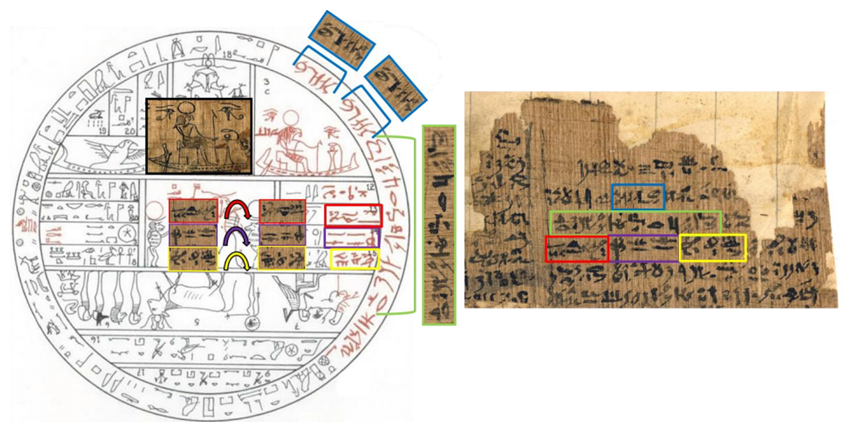
Credit: The Book of Abraham: Criticisms, Defenses, and Implications
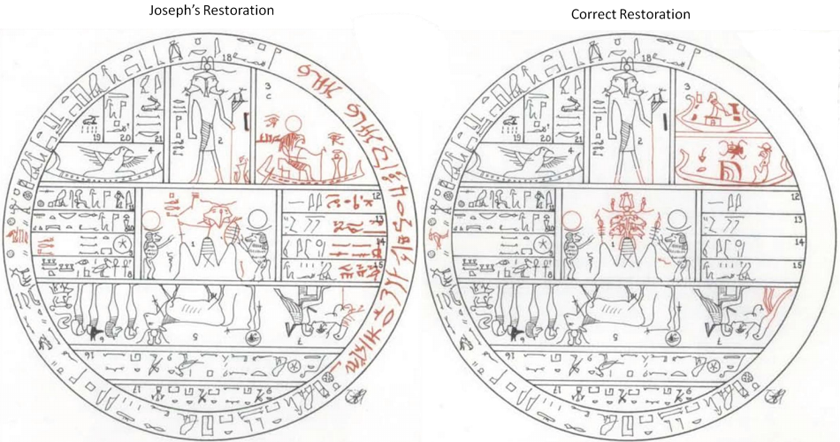
Credit: The Book of Abraham: Criticisms, Defenses, and Implications
Further, Joseph not only copied the above hieroglyphics into Facsimile 2, but he copied the following boat picture from the un-translated Book of Joseph papyrus to fill in the damaged section on the top right part of Facsimile 2:
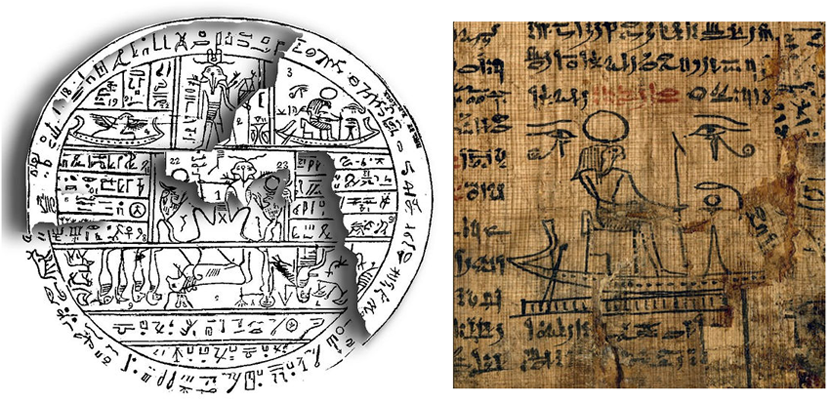
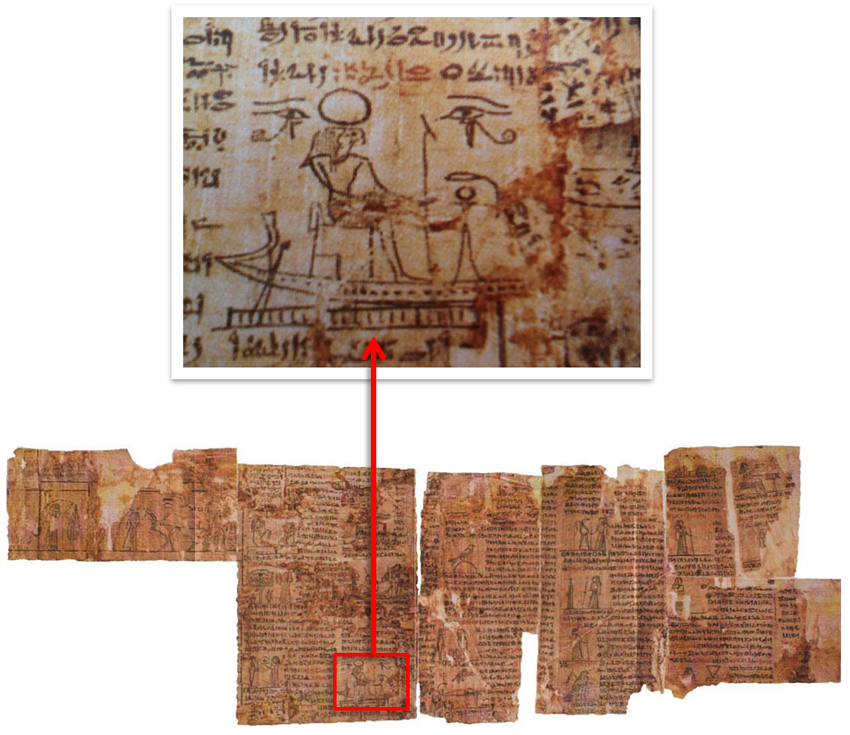
There is more evidence of the Book of Mormon setting being in Joseph Smith’s region than there is for FairMormon’s fringe Limited Geography Model. The following links are some examples of hypothetical Book of Mormon geography maps illustrated by apologists:
As shown by these examples, Limited Geography apologists cannot even agree on where the events of the Book of Mormon took place. They have no real geographical setting in which to set the Book of Mormon. Not only do they have to ignore the similarities in town names in Joseph’s backyard but they have to ignore Joseph Smith and other “prophets, seers, and revelators” who taught that the Book of Mormon took place in New York, Illinois, and elsewhere on the North American continent. Joseph even pointed to the Hill Cumorah as the actual Hill Cumorah in the Book of Mormon. This is not good enough, however, for Limited Geography apologists who insist they know better than Joseph Smith, latter-day “prophets, seers, and revelators” and the Church itself.
Hill Cumorah
"The largest city and capital of Comoros (formerly 'Camora')? Moroni. 'Camora' and settlement 'Moroni' were common names in pirate and treasure hunting stories involving Captain William Kidd (a pirate and treasure hunter) which many 19th century New Englanders – especially treasure hunters – were familiar with. In fact, the uniform spelling for Hill Cumorah in the 1830 edition of the Book of Mormon is spelled as 'Camorah'."
- Mutually exclusive claims - When critics need an attack against the Church, any excuse will do, even if they are mutually self-contradictory. If one argument is true, the other cannot be.
In the previous section, the author suggests that Joseph came up with the name “Moroni” by looking at the name “Monroe” on a map of the region surrounding New York. Now he is suggesting that the name “Moroni” came from stories about Captain Kidd.
FairMormon deleted their above response. See screenshot.
Jeremy's Response to FairMormon
I agree with FairMormon. It was an honest oversight on my part to include Holley’s “Monroe = Moroni” claim, which I do not agree with. I removed Holley’s “Monroe = Moroni” claim.
I stand by my assertion that Joseph Smith got “Camorah” and “Moroni” from Captain Kidd stories, which included adventures on what is now known as the Comoros Islands as I detailed in the CES Letter and which I expand upon further below.
- The 1830 Book of Mormon uses the spelling “Camorah.” Oliver Cowdery stated that this was a spelling error in the July 1835 issue of the Latter Day Saint’s Messenger and Advocate:
By turning to the 529th and 530th pages of the book of Mormon you will read Mormon’s account of the last great struggle of his people, as they were encamped round this hill Cumorah. (It is printed Camorah, which is an error). - The spelling was corrected to “Cumorah” in the 1837 reprint of the Book of Mormon. This makes it consistent with other Nephite names with the phrase “cum” (for example, Teancum). There are no Nephite names which contain “cam.”
FairMormon deleted their above response. See screenshot.
Jeremy's Response to FairMormon
Yes, FairMormon, we know that they eventually got around to correcting the so-called “spelling error,” which is why I had to refer to the original spelling in the 1830 edition of the Book of Mormon.
It’s worth pulling out what I wrote in the CES Letter on this topic:
Off the eastern coast of Mozambique in Africa is an island country called “Comoros.” Prior to its French occupation in 1841, the islands were known by its Arabic name, “Camora.” There is an 1808 map of Africa that refers to the islands as “Camora.”

Camora is near center in the above 1808 Map of Africa
The largest city and capital of Comoros (formerly “Camora”)? Moroni. “Camora” and settlement “Moroni” were common names in pirate and treasure hunting stories involving Captain William Kidd (a pirate and treasure hunter) which many 19th century New Englanders – especially treasure hunters – were familiar with.
In fact, the uniform spelling for Hill Cumorah in the 1830 edition of the Book of Mormon is spelled as “Camorah.”
I’ll leave it to the reader to decide on whether or not the consistent uniform spelling of “Camorah” in the 1830 Book of Mormon is coincidentally and simply just a “spelling error.”
- Unsupported Assertion:
The author states that Camora and Moroni were “common names in pirate and treasure hunting stories involving Captain William Kidd,” but does not cite a single source that can be checked.
FairMormon deleted their above response. See screenshot.
Jeremy's Response to FairMormon
FairMormon deleted the following FairMormon comment on November 28, 2013:
"Pointing out a possible relationship like
Comoros = Cumorah and Moroni = Moroni is not sufficient."
Only in FairMormon universe is Camora = Camorah and Moroni = Moroni “not sufficient” yet an “NHM” carved on an altar in the Middle East is sufficient evidence for “Nahom.”
"The author states that Camora and Moroni were "common names in pirate and treasure hunting stories involving Captain William Kidd," but does not cite a single source that can be checked."

Captain Kidd has a direct connection to Comoros islands. The islands were a part of his famous adventures and stories.
In February 1697, Kidd landed his Adventure Galley ship at the island of Mehila in the Comoros. The ship required repairs after the long voyage from New York. It was in the Comoros that Kidd lost 50 of his crew members to fever and disease; all in the span of one week.
It was during this crisis that Kidd became really concerned about his situation. He left London almost a year previously and he had still not taken a prize. The terms of his agreement required him to be back in Boston the following month with his booty. Kidd’s provisions were running low and he was desperate. With his ship repaired and more crew members recruited to replace the crew that died, Kidd set sail to the Comoros island of Johanna on March 18, 1697.
The following map from Wikipedia outlines Captain Kidd’s journey and pirating activities between April 1696 – April 1698. Notice Kidd’s infamous stop on the Comoros islands in March 1697.
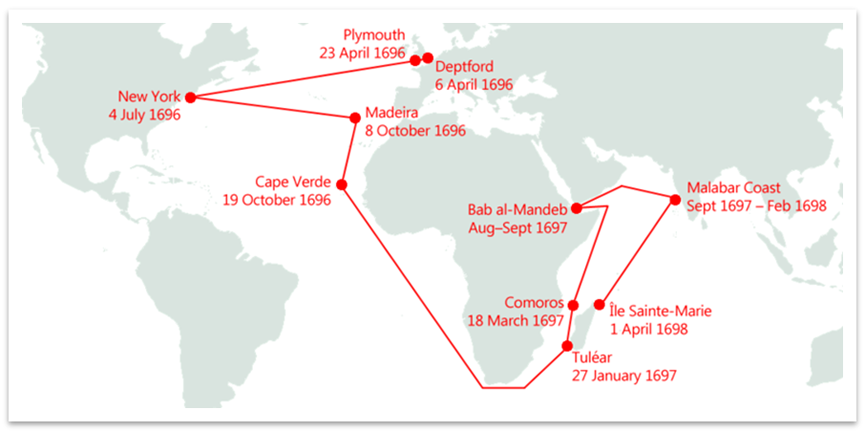
Source: Wikipedia
The following is a 1748 map of the Comoros island of Johanna (also known as “Anjouan”). “Meroni” appears on this map as an anchorage port for the village. Captain Kidd visited the Johanna island twice and was familiar with Meroni as it was a port.
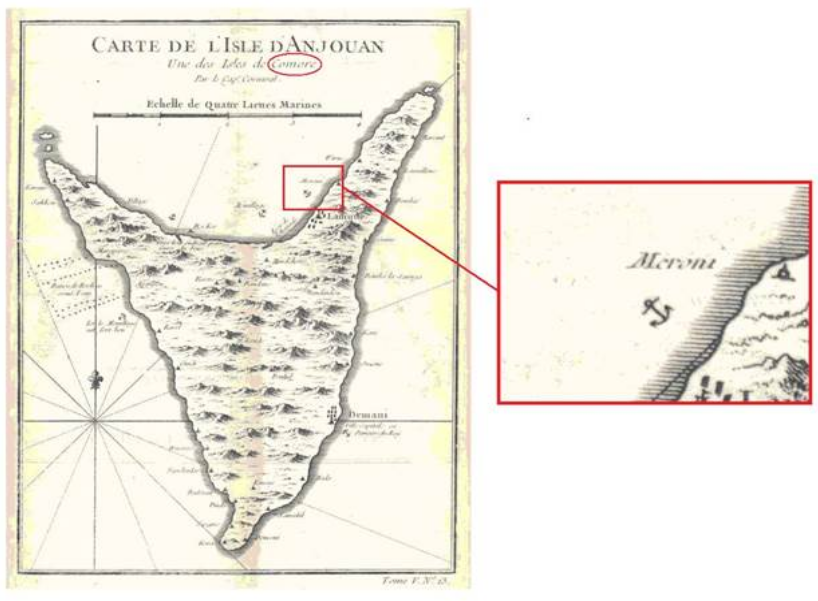
For some Mormon apologists, the evidence is so compelling that they have suggested that Lehi and his family may have encountered the Comoros islands on their initial voyage from the Arabian Peninsula to the western hemisphere, and that the Nephite civilization therefore may have retained a collective knowledge of the names of “Comoros” and “Moroni”.
Captain Kidd spent considerable time in the Comoros islands and the Indian Ocean between 1697-1698 seizing booty from the French and other ships. Shortly after Kidd returned to New York in 1699, Kidd was arrested for killing one of his crew members by the name of Moore. He was also arrested for capturing a treasure ship called the “Quedagh Merchant” in the Indian Ocean near the Comoros islands.
Professor Ronald Huggins wrote:
“The fact that the pirate [Kidd] was hanged for crimes allegedly committed in the vicinity of Moroni on Grand Comoro [Island] is significant.” – “From Captain Kidd’s Treasure Ghost to the Angel Moroni”, p.19
- Incorrect:
It is unlikely that any source would have contained the name of “Moroni.” That settlement did not become the capital city until 1876 (32 years after Joseph’s death and 47 years after the publication of the Book of Mormon), when Sultan Sa’id Ali settled there. At that time it was only a small settlement. Even a century later, in 1958, its population was only 6500.
FairMormon deleted their above response. See screenshot.
Jeremy's Response to FairMormon
"It is unlikely that any source would have contained the name of ‘Moroni’."
FairMormon is incorrect.

The above 1748 map of Anjouan/Johanna has “Meroni” as an anchorage point for the village.
Camora and the Moroni were part of Captain Kidd’s adventures and stories, which captivated young Joseph Smith and his family’s imagination. The following testimonies and statements from Joseph’s Palmyra peers and neighbors attest to this:
Joseph “had learned to read works of fiction and records of criminality, such for instance as would be classed with the ‘dime novels’ of the present day. The stories of Stephen Buroughs and Captain Kidd, and the like, presented the highest claims for his expanding mental perceptions.” – Pomeroy Tucker, Origin, Rise, and Progress of Mormonism
Joseph as a boy “had for a library a copy of the ‘Arabian Nights,’ stories of Captain Kidd, and a few novels.” – Philetus Spear, Early Mormon Documents 3:130
Joseph Smith, Sr., Joseph’s father, was “at times engaged in hunting for Captain Kidd’s buried treasure,” and that young Joseph’s own reading about the pirate had “made a deep impression on him.” – James H. Kennedy, Early Days of Mormonism: Palmyra, Kirtland and Nauvoo, p. 8,13.
Captain Kidd was “his [Joseph, Jr.] hero.” – Ann Eaton, Early Mormon Documents, 3:148
Fascination with Captain Kidd was not limited to young Joseph Smith. It was prevalent and widespread among many individuals, especially treasure hunters – which Joseph and some of his family were – in early 19th century New York and New England. The search for buried treasure was motivated by Captain Kidd’s legend and other pirate lore.
Further reading:
- From Captain Kidd’s Treasure Ghost to the Angel Moroni
- Joseph Smith, Captain Kidd, Cumorah and Moroni
- Joseph Smith, Captain Kidd Lore, and Treasure-Seeking in New York and New England during the Early Republic
- Answer:
In a search for references to Comorah and Moroni, the following gazetteers from Joseph’s era were consulted. There is no evidence that Joseph saw these maps, or any other, but if he had they would have provided little help.
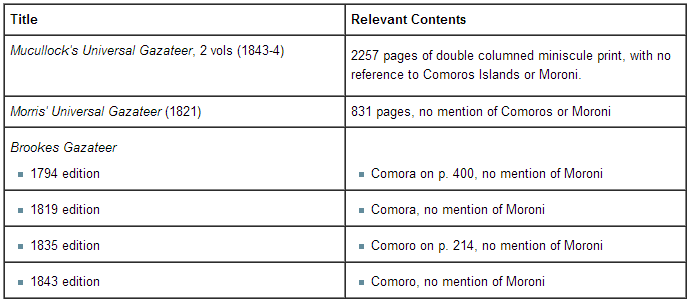
FairMormon deleted their above response. See screenshot.
Jeremy's Response to FairMormon
FairMormon commits a strawman fallacy. I never claimed that Joseph used maps or that he searched in maps for “Camora” and “Moroni.” I claim that he learned about the islands and “Moroni” from Captain Kidd stories and adventures, which the evidence show Joseph was captivated and familiar with.
The following is an example of FairMormon disingenuity and modus operandi:
On FairMormon’s other “Comoros/Moroni” page on their website, FairMormon claims the following:
“Advocacy of the Comoros/Moroni link seems an act of desperation. It has not been proved that Joseph saw the names, or that any source available to him linked them. Furthermore, latching on to two names in an obscure reference work does nothing to explain the incredible complexity and internal consistency of the Book of Mormon…This claim, like many efforts to explain away the Book of Mormon, commits the logical fallacy of the Appeal to probability. This fallacy argues that because something is even remotely possible, it must be true.”
FairMormon’s entire focus in that section along with this section is on maps and gazetteers. FairMormon completely ignores the amazing evidence from Captain Kidd, his adventures, and Joseph’s obsession with Kidd. FairMormon does not offer to their readers this evidence. Instead, they create a strawman and then they misapply the “appeal to probability” fallacy to the strawman they created while leaving their Latter-day Saint readers completely in the dark about the amazing Captain Kidd evidences and links to Joseph Smith and his peers.
Here’s a parallel which illustrates the absurdity of FairMormon’s positioning and strawman:
Paul, a teenager, loves reading Harry Potter. He’s captivated by Potter and the stories. He later creates a story about a land of “Englund” with a wizard by the name of “Wiltshire” (also in Harry Potter stories).
Modeling the same response FairMormon provided with Camora/Moroni to this parallel, a FairMormon response would look something like this:
“This claim commits the logical fallacy of appeal to probability. When the facts are examined, even the possibility of your son seeing England and Wiltshire recedes; the idea becomes absurd. The following references were consulted from the Paul’s school library:
Encyclopedia Britannica, 32 volumes. Relevant contents: 32,640 pages of double columned minuscule print, with only two references to England or Wiltshire.
US Gazetteer, US Census. Relevant contents: thousands of dynamic web pages of technical text, with no references to England or Wiltshire."
See how ridiculous this is? Paul knows the names from the story. Joseph Smith knew the names from Captain Kidd stories. Neither Paul nor Joseph Smith needed to consult reference books or gazetteers and nobody suggested that he did.
View of the Hebrews compared to the Book of Mormon
The document claims extensive parallels between the 1825 book View of the Hebrews and the Book of Mormon.
- Many of the criticisms proposed by the View of the Hebrews theory are based upon B. H. Roberts' list of parallels, which only had validity if one applied a hemispheric geography model to the Book of Mormon.
FairMormon deleted their above response. See screenshot.
Jeremy's Response to FairMormon
Amazingly, FairMormon concedes that the parallels have “validity” but then adds a “but” at the end: “if one applied a hemispheric geography model to the Book of Mormon.” In other words, B.H. Roberts’ parallels are valid except that they’re not under FairMormon’s fringe Limited Geography theory, which is unsupported and at direct odds with the Church and its “prophets, seers, and revelators.”
Unlike unofficial apologetic attempts to rewrite Mormon history and the Book of Mormon along with overriding the teachings of Joseph Smith and prophets, Joseph Smith and the Church have taught the Hemispheric Geography Model rather than the fringe Limited Geography Model.
The numerous problems that a Limited Geography Model (BOM took place in a small section of either Central or South America) creates:
- Why is what every single prophet, including Joseph Smith (who claimed to have been taught about Book of Mormon civilizations by the inhabitants themselves), believed about the Book of Mormon wrong? Are unofficial apologists such as FairMormon to now be believed over the latter-day prophets, seers, and revelators?
- Joseph Smith’s testimony in the Book of Mormon: “[The angel Moroni] said there was a book deposited, written upon gold plates, giving an account of the former inhabitants of this continent [not just a small chunk of Central America thousands of miles away from New York], and the source from whence they sprang.” (Emphasis added)
- In June 4, 1834, Joseph Smith wrote a letter to his wife Emma while traveling through Illinois that he and others had been “wandering over the plains of the Nephites, recounting occasionally the history of the Book of Mormon, roving over the mounds of that once beloved people of the Lord, picking up their skulls and their bones, as proof of its divine authenticity.”
– The Personal Writings of Joseph Smith, Dean Jessee, 1984 - “The camp passed through Huntsville, in Randolph County, which has been appointed as one of the Stakes of Zion, and is the ancient site of the City of Manti.”
– The Latter-day Saints’ Millennial Star, “History of Joseph Smith”, Volume 16 - How do you explain all of the other people who existed in the Americas independently of the Book of Mormon who have been wiped out in the great Flood? The Book of Mormon describes how this land was preserved for the Book of Mormon inhabitants and makes no mention of other people.
- Joseph Smith stated the following in the 1842 Wentworth Letter regarding the Book of Mormon:
“In this important and interesting book the history of ancient America is unfolded, from its first settlement by a colony that came from the Tower of Babel at the confusion of languages to the beginning of the fifth century of the Christian era. We are informed by these records that America in ancient times has been inhabited by two distinct races of people. The first were called Jaredites and came directly from the Tower of Babel. The second race came directly from the city of Jerusalem about six hundred years before Christ. They were principally Israelites of the descendants of Joseph. The Jaredites were destroyed about the time that the Israelites came from Jerusalem, who succeeded them in the inheritance of the country. The principal nation of the second race fell in battle towards the close of the fourth century...”
- Recall that Joseph Smith himself claimed to have been taught about the peoples in the Book of Mormon by Moroni himself:
"I was also informed concerning the aboriginal inhabitants of this country [America] and shown who they were, and from whence they came; a brief sketch of their origin, progress, civilization, laws, governments, of their righteousness and iniquity, and the blessings of God being finally withdrawn from them as a people, was [also] made known unto me; I was also told where were deposited some plates on which were engraven an abridgment of the records of the ancient prophets that had existed on this continent."
- Thus, supporters of the Limited Geography model can’t argue that Joseph Smith misunderstood where the events of the Book of Mormon happened. To do so would be to argue that the angel Moroni lied to Joseph about these events.
- If the Book of Mormon’s geography is limited and based in Central/South America, why is Hill Cumorah, where two great battles that resulted in the deaths of millions and where Moroni buried the plates, in New York? FairMormon and unofficial apologists attempt to get around this problem by proposing their unsupported theory that there is another Hill Cumorah. This is in direct conflict to the teachings of latter-day prophets and the Church.
- Why on Zion’s Camp March through Illinois did Joseph Smith find the bones of a white Lamanite warrior he said was named Zelph who fought a fierce battle on that very spot during one of the last great struggles of the Lamanites and the Nephites? Also, Joseph mentions he was known from the Hill Cumorah, or eastern sea to the rocky mountains.
- Unlike the united front on Limited Geography that FairMormon is attempting to sell, Mormon apologists are currently at war with one another over Hemispheric vs. Limited Geography. One apologist and group, for example, who disagrees with FairMormon is Rodney Meldrum and his Foundation for Indigenous Research and Mormonism (FIRM) organization, who favors a hemispheric model of the Book of Mormon geography.
- Elder L. Tom Perry disagrees with FairMormon’s fringe Limited Geography theory. He’s quoted in the December 2012 Ensign as stating: “The United States is the promised land foretold in the Book of Mormon.” Hemispheric LDS apologist Rodney Meldrum, of course, is all over this.
- “However, as with all archaeological interpretations of the Book of Mormon, most LDS researchers believe that nothing has yet been found to conclusively link the events of the book with any particular geographical location. There are significant challenges to the Central American setting, as the Hill Cumorah (in New York) and the remains of Zelph (in Illinois) were found many thousands of miles away from Mesoamerica. Archaeological evidence supporting the Book of Mormon’s ‘mound-builder’ literary setting is not interpreted by mainstream academia as proving the historicity or divinity of the work. The Book of Mormon is regarded by mainstream historians and literary experts as a work of 19th century American literature, in the ‘mound-builder’ genre but as history.”
– Limited Geography Model, Wikipedia.
Mormon apologists are currently warring with each other over hemispheric vs. limited geography. Limited geography apologists cannot even agree on the location or even its compass direction. Here are just a few examples of the different proposed Limited Geography Maps, just to illustrate the lack of consensus among “Limited Geography” apologists:
- Some parallels do exist between the two books. For example, View of the Hebrews postulates the existence of a civilized and a barbarous nation who were constantly at war with one another, with the civilized society eventually being destroyed by their uncivilized brethren. This has obvious similarities to the story of the Nephites and the Lamanites in the Book of Mormon.
FairMormon deleted their above response. See screenshot.
Jeremy's Response to FairMormon
“Some parallels”? FairMormon is willing to concede only that 34 parallels is “some parallels”? It’s worth reviewing the parallels again for the reader to decide for themselves if it’s only just “some parallels”:
| View of the Hebrews Online Source |
Book of Mormon Online Source |
|
|---|---|---|
| Published | 1823, first edition 1825, second edition |
1830, first edition |
| Location | Vermont Poultney, Rutland County Note: Oliver Cowdery, one of the Book of Mormon witnesses, lived in Poultney when "View of the Hebrews" was published. |
Vermont Sharon, Windsor County Note: Windsor County is adjacent to Rutland County. |
| Destruction of Jerusalem | ||
| Source: B.H. Roberts, Sudies of the Book of Mormon, p.240-242,324-344 | ||

Notice that FairMormon does not dispute the above parallels and even goes further by admitting that the parallels have validity if “one applied a hemispheric geography model to the Book of Mormon.” Never mind that the Church and its “prophets, seers, and revelators” have taught the hemispheric geography model of the Book of Mormon its entire existence.
- The View of the Hebrews theory of Book of Mormon origin originated after the rediscovery of the Spalding manuscript, which led to the original demise of the Spalding Theory. since that time, the Spalding Theory is periodically resurrected. There are a significant number of differences between the two books, which are easily discovered upon reading Ethan Smith's work. This is one of the reasons that BYU republished A View of the Hebrews in the 1990's. Many points that Ethan Smith thought were important are not mentioned at all in the Book of Mormon, and many of the "parallels" are no longer valid based upon current scholarship. Many of the "parallels" that are discussed are not actually parallels at all once they are fully examined:
The destruction of Jerusalem:
- View of the Hebrews: by the Romans in A.D. 70
- Book of Mormon: by the Babylonians in 586 B.C.
Israelites coming to the American continent:
- View of the Hebrews: via dry land across the Bering Strait.
- Book of Mormon: via the ocean on board a ship.
Colonists spread out to fill the entire land:
- View of the Hebrews: from the North to the South.
- Book of Mormon: from the South to the North.
A great lawgiver (whom some assume to be associated with the legend of Quetzalcoatl):
- View of the Hebrews: who is identified as Moses.
- Book of Mormon: who is identified as Jesus Christ.
An ancient book that was preserved for a long time and then buried:
- View of the Hebrews: because they had lost the knowledge of reading it and it would be of no further use to them.
- Book of Mormon: in order to preserve the writings of prophets for future generations.
A buried book taken from the earth:
- View of the Hebrews: in the form of four, dark yellow, folded leaves of old parchment.
- Book of Mormon: in the form of a set of gold metal plates.
A Egyptian Language:
- View of the Hebrews: an Egyptian influence is present in hieroglyphic paintings made by native Americans.
- Book of Mormon: a reformed Egyptian was used to record a sacred history.
FairMormon deleted their above response. See screenshot.
Jeremy's Response to FairMormon
Think about FairMormon’s logic here for a moment. It presumes that if the Book of Mormon doesn’t mention, include, or align exactly with everything found in View of the Hebrews, then there must not be any real relationship between the two books. This is absurd nonsense. There are always “unparrallels” between any two books in the world – unless one was copied verbatim from the other.
The evidence does not support that Joseph & Co. copied everything from one single source. The evidence supports that Joseph & Co. borrowed a few things here and a few things there. Joseph & Co. borrowed the story of the Tree of Life in Lehi’s Dream, for example, from Joseph’s father’s 1811 dream. They borrowed from View of the Hebrews as evident from the above 34 parallels. They borrowed from the Late War. They borrowed from early 19th century Methodist evangelical camp meetings and the Second Great Awakening in Joseph’s “burnt over district” backyard. They borrowed from anti-Masonic sentiments of Joseph’s time. They borrowed from First Napoleon. They borrowed from the 1769 King James Version Bible (including its errors and italics). They borrowed from other papyri to fill in the blanks in the damaged Facsimiles. They borrowed from Philosophy of a Future State. They borrowed from the Masonic rituals in the Nauvoo Masonic Lodge for the creation of the LDS Endowment ceremony a few weeks later. They borrowed from many different sources.
Not only does FairMormon not dispute the above-mentioned B.H. Roberts parallels, but FairMormon attempts to dismiss and diminish by hand-waving them away by pointing to their unsupported “Limited Geography” theory, which they call “current scholarship.” There is no overall consensus. Nor is there any non-Mormon/BYU peer-reviewed data. Until unofficial Mormon apologists can actually agree on a location and produce data and evidence that they can present in a non-Mormon journal for peer-review by non-biased independent archaeologists and scientists, there is nothing “scholarly” about their unsupported hypothesis.
LDS historian, scholar, and General Authority B.H. Roberts read the View of the Hebrews. He researched it inside and out. Elder B.H. Roberts disagrees with FairMormon’s assessment as the parallels to the Book of Mormon led Elder Roberts to the following conclusion:
“Did Ethan Smith’s View of the Hebrews furnish structural material for Joseph Smith’s Book of Mormon? It has been pointed out in these pages that there are many things in the former book that might well have suggested many major things in the other. Not a few things merely, one or two, or half dozen, but many; and it is this fact of many things of similarity and the cumulative force of them that makes them so serious a menace to Joseph’s story of the Book of Mormon origins.”
– B.H. Roberts, Studies of the Book of Mormon, p.240
Elder B.H. Robert’s private assessment (it was an internal report meant only for the First Presidency and Quorum of Twelve) of the evidence of the View of the Hebrews against the Book of Mormon, which includes the numerous parallels and the fact that Oliver Cowdery was a member of the View of the Hebrews author’s congregation, made Roberts come to a very different conclusion than FairMormon: "the cumulative force of the evidence [of the View of the Hebrews] is a 'serious menace to Joseph’s story of the Book of Mormon origins'."
Rather than directly respond to each one of the 34 parallels between the View of the Hebrews and the Book of Mormon as well as Oliver Cowdery’s direct connection to his pastor, author Ethan Smith, FairMormon attempts to distract and divert from the real issue by claiming “there are a significant number of differences between the two books” while ignoring that there are a significant number of similarities between the two books. FairMormon also states, “many points that Ethan Smith thought were important are not mentioned at all in the Book of Mormon” while failing to mention that many points in the book that Ethan Smith thought were important are mentioned in the Book of Mormon.
We know that Joseph Smith knew about and was familiar with View of the Hebrews. We know Joseph knew about the book because he mentioned and quoted from View of the Hebrews in his Times and Seasons newspaper:
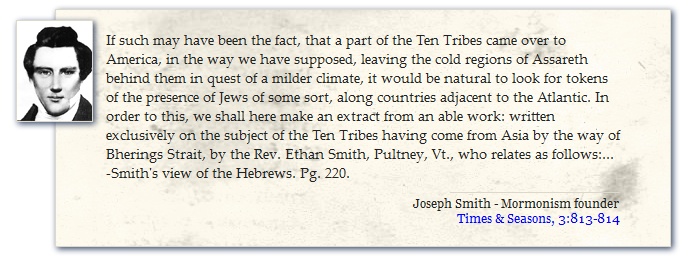
Here are screenshots of the Times and Seasons newspaper with the View of Hebrews content. You can see for yourself on BYU's website here. Volume 3. No. 15. "From Priest's American Antiquities."
FairMormon has failed to directly respond to the problem of Oliver Cowdery’s own pastor being the author of the View of the Hebrews. FairMormon has failed to directly answer why a book, that has as many as 34 parallels to the Book of Mormon and which greatly troubled LDS scholar and General Authority B.H. Roberts, is nonsense and has zero influence on the Book of Mormon - despite all the evidence given to the contrary.
The Book of Mormon taught and still teaches a Trinitarian view of the Godhead
"The Book of Mormon taught and still teaches a Trinitarian view of the Godhead."
- The earliest edition of the Book of Mormon referred to Jesus as "God," but in later editions some, but not all, of these references were changed to "the Son of God."
FairMormon deleted their above response. See screenshot.
Jeremy's Response to FairMormon
Precisely. The first edition of the Book of Mormon in particular espoused a Trinitarian view of the Godhead. This view was later revised as Joseph's doctrinal teachings evolved.
- The second edition of the Book of Mormon was published in 1837 at Kirtland, Ohio. The typesetting and printing were done during the winter of 1836–37, with Joseph Smith and Oliver Cowdery taking an active part in the editing process. In this edition numerous corrections were made to the text of the 1830 (first) edition to bring it back to the reading in the original and printer's manuscripts. Joseph Smith also made a number of editorial changes to the text. Among the changes he made are these four in 1 Nephi 11 and 13:
FairMormon deleted their above response. See screenshot.
Jeremy's Response to FairMormon
“In this edition numerous corrections were made to the text of the 1830 (first) edition to bring it back to the reading in the original and printer's manuscripts.”
This is deceptive. Some quick background on the Book of Mormon manuscripts from LDS scholar Royal Skousen:
The printed versions of the Book of Mormon derive from two manuscripts. The first, called the original manuscript (O), was written by at least three scribes as Joseph Smith translated and dictated. The most important scribe was Oliver Cowdery. This manuscript was begun no later than April 1829 and finished in June 1829.
A copy of the original was then made by Oliver Cowdery and two other scribes. This copy is called the printer's manuscript (P), since it was the one normally used to set the type for the first (1830) edition of the Book of Mormon. It was begun in July 1829 and finished early in 1830.
The printer's manuscript is not an exact copy of the original manuscript. There are on the average three changes per original manuscript page. These changes appear to be natural scribal errors; there is little or no evidence of conscious editing. Most of the changes are minor, and about one in five produce a discernible difference in meaning. Because they were all relatively minor, most of the errors thus introduced into the text have remained in the printed editions of the Book of Mormon and have not been detected and corrected except by reference to the original manuscript. About twenty of these errors were corrected in the 1981 edition.
The compositor for the 1830 edition added punctuation, paragraphing, and other printing marks to about one-third of the pages of the printer's manuscript. These same marks appear on one fragment of the original, indicating that it was used at least once in typesetting the 1830 edition.
In preparation for the second (1837) edition, hundreds of grammatical changes and a few textual emendations were made in P [Printer’s Manuscript].
Here’s FairMormon’s chart again showing the Original Manuscript, Printer’s Manuscript, 1830 edition, and 1837 edition:
Click on graphic to expand:
Notice the strikeouts and strikeouts and
Therefore, FairMormon’s “in this edition numerous corrections were made to the text of the 1830 (first) edition to bring it back to the reading in the original and printer's manuscripts” wording and claim is deceptive and false. It was not bringing it “back to the reading” of anything. The new changes were struck out and inserted into the Printer’s Manuscript in 1837 by Joseph Smith. It was not bringing it “back to the reading in the original and printer’s manuscripts.” It was not referring to any original wording made before and for the 1830 edition.
- These changes are clarifications that the passages are speaking of Jesus, not God the Father. The terms "God," "Everlasting God," and "Eternal Father" are ambiguous since they could properly refer to either the Father or the Son. For example, "Eternal Father" refers to God the Father in Moroni 4:3, Moroni 5:2, and Moroni 10:4, but to God the Son in Mosiah 16:15 and Alma 11:38-39. The addition of "the Son of" to four passages in 1 Nephi does not change the Book of Mormon's teaching that Jesus Christ is the God of Old Testament Israel. This concept is taught in more than a dozen other passages whose readings remain unchanged from the original manuscripts. For example:
- "And the God of our fathers, who were led out of Egypt, out of bondage, and also were preserved in the wilderness by him, yea, the God of Abraham, and of Isaac, and the God of Jacob, yieldeth himself...as a man, into the hands of wicked men, to be lifted up...and to be crucified...and to be buried in a sepulchre...." (1 Nephi 19:10)
- "...he said unto them that Christ was the God, the Father of all things, and said that he should take upon him the image of man, and it should be the image after which man was created in the beginning; or in other words, he said that man was created after the image of God, and that God should come down among the children of men, and take upon him flesh and blood, and go forth upon the face of the earth." (Mosiah 7:27)
- "Teach them that redemption cometh through Christ the Lord, who is the very Eternal Father." (Mosiah 16:15)
- "Now Zeezrom saith again unto him: Is the Son of God the very Eternal Father? And Amulek said unto him: Yea, he is the very Eternal Father of heaven and of earth, and all things which in them are; he is the beginning and the end, the first and the last." (Alma 11:38-39)
FairMormon deleted their above response. See screenshot.
Jeremy's Response to FairMormon
“These changes are clarifications that the passages are speaking of Jesus, not God the Father. The terms ‘God,’ ‘Everlasting God,’ and ‘Eternal Father’ are ambiguous since they could properly refer to either the Father or the Son.”
This is not how Joseph and the early Saints interpreted it. This is FairMormon applying current 21st century LDS doctrine and teachings of the Godhead to a book that held and still holds Trinitarian teachings of God; views that Joseph clearly expressed in the Book of Mormon, in his “inspired” translation of the Bible as well as what he wrote and taught in the Lectures on Faith.
“The addition of "the Son of" to four passages in 1 Nephi does not change the Book of Mormon's teaching that Jesus Christ is the God of Old Testament Israel.”
This is a strawman fallacy. I never made the claim that the Book of Mormon teaches or does not teach that “Jesus Christ is the God of Old Testament Israel.”
Since we’re on this topic, here’s what I stated in the CES Letter:
As a believing Mormon, I tried to rationalize some of the craziness by saying, “Oh, this is in the crazy Old Testament when the Law of Moses was in force. Christ came and fulfilled the Law of Moses.”
The problem with this is that the crazy god of the Old Testament was Jehovah. Who’s Jehovah? The premortal Jesus Christ. So, Christ is the crazy god of the Old Testament. The Christ of the Old Testament and the Christ of the New Testament are light years different. Again, I’m asked to believe in not only a part-time racist god and a part-time polygamous god but a part-time psychopathic schizophrenic one as well.
"This concept is taught in more than a dozen other passages whose readings remain unchanged from the original manuscripts."
Although one of the passages cited by FairMormon (1 Nephi 19:10) supports that Jesus Christ is the God of the Old Testament (a position which with I have never disagreed), that passage neither supports nor detracts from a Trinitarian position in the original Book of Mormon.
The other three passages cited by FairMormon, (Mosiah 7:27, Mosiah 16:15, and Alma 11:38-39), on the other hand, simply confirm that the original Book of Mormon (and to a lesser extent the existing Book of Mormon) is Trinitarian. A plausible explanation for the fact that these versus remain unchanged today is simply that perhaps they were missed by Joseph Smith and Oliver Cowdery during the preparation of the 1837 edition.
Perhaps the most damning portion of FairMormon’s response on this matter is what FairMormon didn’t say. The strongest evidence that the original Book of Mormon is not Trinitarian would be language clearly delineating God the Father from Christ the Son. But there is no such language in the original Book of Mormon. And there is plenty of language in the original, along with Joseph Smith’s contemporaneous teachings and writings, that supports a Trinitarian view.
The significance of this issue cannot be understated. Aside from the Book of Abraham, this one issue perhaps comes as close to being a “silver bullet” as any other. Until the late 1830s, Joseph Smith taught for years that God the Father and the Son were one being. There is no contemporaneous evidence to the contrary, and there is overwhelming evidence in support of this fact.
Of course, Trinitarianism is utterly at odds with the official 1838 account of the First Vision and with the Church’s current teachings today. Joseph’s early teachings on Trinitarianism and the official First Vision account cannot both be true. Either Joseph was visited by God the Father and the Son as separate beings in 1820 or he wasn’t. Joseph’s Trinitarian teachings severely (and, for many, completely) undermine Joseph’s credibility as a prophet.
The following FairMormon response was deleted by FairMormon on July 28, 2013:
- Joseph and the early Saints were not trinitarian, and understood God's embodiment and the identity of the Father and Son as separate beings very early on. This doctrine is apparent in the Book of Mormon, and in the earliest friendly and non-friendly accounts of such matters from the Saints. Such texts demonstrate that the supposed 'evidence' for Joseph altering his story later is only in the eyes of critical beholders.
Jeremy's Response to FairMormon
Why did FairMormon delete their above original response? Note that, unlike FairMormon’s above strong denial which they deleted, FairMormon’s new response does not deny that Joseph held a Trinitarian theology during the Book of Mormon translation and publication.
The evidence is in the Book of Mormon and Joseph’s own contemporaneous writings, including the Lectures on Faith. Joseph even changed the Bible in his revision to ensure it did not read that God and Jesus were separate beings. FairMormon not only fails to address this, but they fail to directly respond to the evidence I presented in the CES Letter of Trinitarian verses in the Book of Mormon, some of which were updated in 1837 to better reflect Joseph’s evolved theology that Mary was not the mother of God and that the lamb of God was not the everlasting god and that the lamb of God was not the Eternal Father.
Here is some additional evidence of Joseph’s early theology holding a Trinitarian view:
Luke 10:22 KJV reads:
“…no man knoweth who the Son is, but the Father; and who the Father is, but the Son, and he to whom the Son will reveal him.”
This verse can be construed as slightly ambiguous. It could be argued, although weakly, considering what the rest of the Bible contains, that it means God and Jesus are two separate and individual beings. So, ironically, Joseph – in his monotheistic framework – changed it to clarify that God and Jesus are one and the same. It becomes verse 23 in the Joseph Smith Inspired Translation of the bible:
“…that the Son is the Father, and the Father is the Son, but him to whom the Son will reveal it.” (Emphasis added) – JST Luke 10:23
If Joseph already thought that God and Jesus were two separate beings with bodies, why did he alter or correct a Bible verse that could have been taken that way and rewrite it to unmistakably read that they are definitely one and the same being? Why did Joseph make this change a decade after supposedly seeing that the Son was not the Father and the Father was not the Son in the sacred grove in 1820?
Additionally, the Lectures on Faith (1834) include references to God as a spirit alone:
“There are two personages who constitute the great matchless, governing, and supreme power over all things...They are the Father and the Son – the Father being a personage of spirit, glory, and power, possessing all perfection and fullness, the Son, who was in the bosom of the Father, a personage of tabernacle..." (Emphasis added)
Why is Joseph saying that the Father is a “personage of spirit” while saying the Son is a “personage of “tabernacle” in 1834? If Joseph saw that they were both personages of “tabernacle” 14 years earlier in 1820 in the sacred grove?
Elsewhere in the lectures (Lectures on Faith), God is referred to as an omnipresent spirit which means He dwells everywhere at once, and that is yet another traditional monotheistic Christian concept. The ‘holy spirit’ by the way, is the ‘mind of God’ in these lectures and is nowhere referred to as a ‘personage’ of spirit. Most Mormons have no idea the concept of the Holy Ghost being a personage of spirit didn’t actually become formal doctrine until the twentieth century.” – Sunstone, July/August 1980, p. 24-33
FairMormon has failed to respond directly to the evidence provided of Trinitarian verses in the Book of Mormon, Joseph Smith Translation of the Bible, and the Lectures on Faith. When one reads the multiple First Vision accounts written by Joseph, they can see that the accounts gradually evolve into polytheism by the official 1842 account.
I’m going to let Brother Jake quickly wrap up the Book of Mormon:


